Archive for the ‘Threats from Road Making’ Category
Saturday, August 18th, 2012
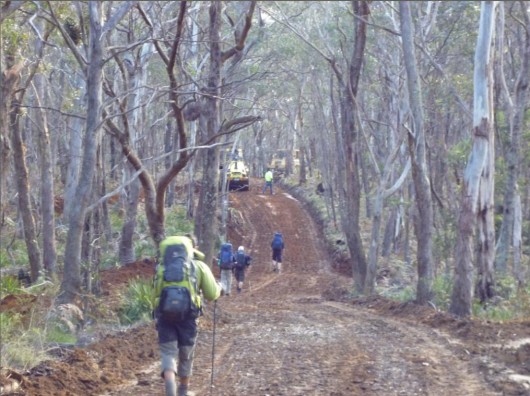 Six Foot Track being bulldozed into a two-laned RFS Fire Trail
(Photo by Daniel Kelton, 20120802) Six Foot Track being bulldozed into a two-laned RFS Fire Trail
(Photo by Daniel Kelton, 20120802)
.
News is filtering out that a large section of the iconic Six Foot Track has been bulldozed and vast swathes of forest destroyed.
The Six Foot Track starts from the Blue Mountains west of Sydney near the famous Explorers’ Marked Tree on the Great Western Highway near Katoomba and traces through wild gorges, forests and over ridges to the famous Jenolan Caves, some 42km to the south-west.
‘The Track descends via Nellies Glen to the Coxs River and then climbs Blacks Range before descending again to the Jenolan River by way of Binomea Ridge. In traversing The Track walkers cross a number of distinct cultural and physical landscapes.
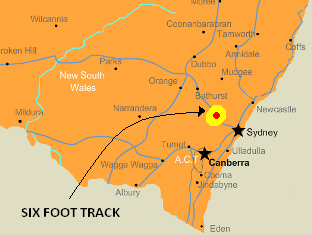 . .
 [Source: ^http://www.adventure.com.au/SixFootTrack.asp] [Source: ^http://www.adventure.com.au/SixFootTrack.asp]
.
William Cooper was instructed in 1884 to undertake a survey of a bridle track between Katoomba and Jenolan Caves. Cooper also supervised the construction of a track which had a width of six feet following approval by the New South Wales Parliament.’ [Source: ‘Six Foot Track Conservation and Management Plan’, 1997, Foreword, prepared by Integrated Site Design Pty Ltd in association with Jim Smith for the Six Foot Track Heritage Trust].
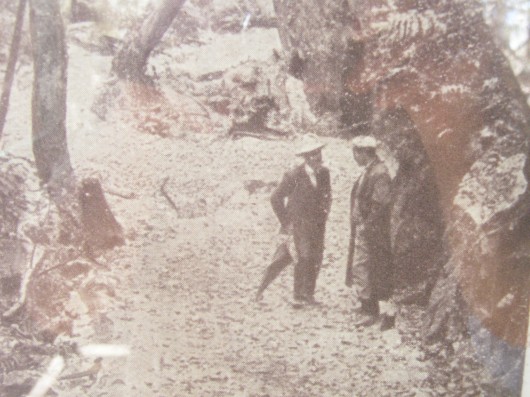 The 19th Century Heritage of the Six Foot Track
(An old photo at the information shelter at the start of The Track) The 19th Century Heritage of the Six Foot Track
(An old photo at the information shelter at the start of The Track)
.
Aug 2012: Track Bulldozed
.
Two weeks ago, on Thursday 2nd August 2012, an Outdoor Recreation Lecturer leading a group of students along the Six Foot Track happened across a crew of construction workers driving bulldozers and in the process of destroying the Six Foot Track. The section of the track affected is situated between Allum Creek and the Black Range Campsite.
When challenged, the construction workers said that the work had been approved by Oberon Council and Kanangra Boyd National Parks Office. They were calling it “road maintenance“.
So much for the Six Foot Track and its 19th Century heritage. It is now a six metre wide road so that fire trucks can hoon along ringing their fire bells in the middle of the forest. In some places the Track has been bulldozed it to 30 metres wide!
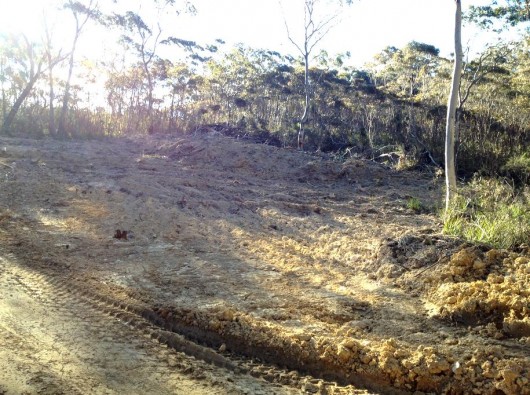 Six Foot Track bulldozed beyond recognition
(Photo by Daniel Kelton, 20120802) Six Foot Track bulldozed beyond recognition
(Photo by Daniel Kelton, 20120802)
.
Daniel Kelton, an Outdoor Recreation Lecturer at TAFE and a Bush Walking Guide for a regional commercial company leads regular walks along the Six Foot Track more than twenty times a year.
“I saw numerous earth moving machines blocking the iconic track, doubling the width of the original fire trail in places, I saw many old growth trees bulldozed and pushed into the bush in piles, I saw water drains driven excessively into the vegetation on each side of the track. I witnessed stunned native birds walking amongst the newly felled trees. The impact is over a 15km section of the 6ft Track and has impacted up to 30 metres each side of the original fire trail”, Mr Kelton said.
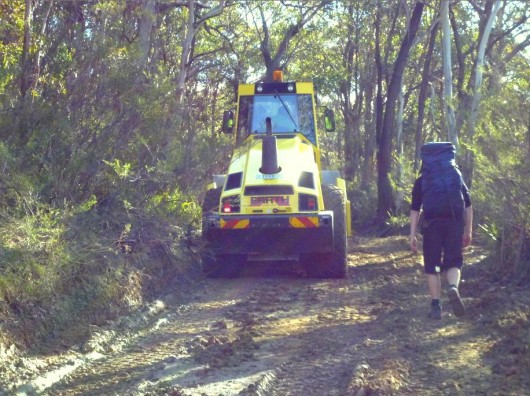 . .
Initial investigation has revealed that the earth works were given the go ahead by Oberon Council Engineering Service’s works manager, Ian Tucker, and the Oberon Area Manager with the New South Wales National Parks and Wildlife Service (NPWS), Kim De Govrik, apparently without any environmental, hydrological, or cultural heritage assessments or supervision.
After initial complaints being made to National Parks and Wildlife Service office and Oberon Shire Council from Friday 27th July, road works where substantially decreased, yet Aboriginal sites were damaged after these concerns where raised.
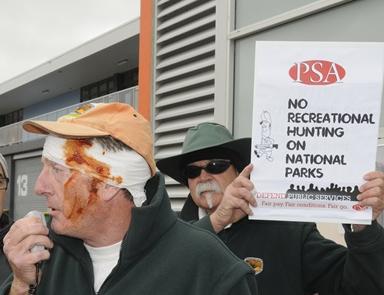 NPWS Oberon Area Manager, Kim De Govrik, in mock bandage leading a protest rally last June NPWS Oberon Area Manager, Kim De Govrik, in mock bandage leading a protest rally last June
[Source: Western Advocate newspaper, Photo by Chris Seabrook,
^http://www.westernadvocate.com.au/story/96608/riled-rangers-target-national-park-hunts/]
.
Wanton Destruction of Habitat and Cultural Sites
.
Initial onsite investigation has confirmed the following damage caused along the Six Foot Track:
.
- Aboriginal Sites have been destroyed at Mini Mini Saddle, Kyangatha Station and Alum Creek along the Track
- Road works have been bulldozed to within less than a metre of watercourses along Little River (large piles of dirt waiting to be washed into the river in the next rain)
- Counted 213 mature native trees pushed over with a 300 mm or more Diameter at Breast Height (DBH)
- At least 23 hollow forming (habitat) trees pushed over
- Heritage listed fence post and gate from the old Kyangatha Station knocked down and has disappeared.
- The Six Foot Track has been widened, up to double its original width, “For fire trucks to pass” as explained by NPWS Oberon Office
- Water mitre drains have been pushed into the bush up to 50 metres in length
- Considerable destruction of native vegetation and top soil removal through wetland areas, which may fall under the ecosystem classification of a Montane Peatlands (Temperate Highland Swamps on Sandstone?)
- Water drains have been created in inappropriate or unnecessary locations
- Piles of soil have been graded into Spring Gully at Grid Reference 2234450E 62603500N, with no silt trap to prevent siltation of the watercourse
- Vast areas of exposed soil left will inevitably attract weeds
- Large amounts of non-road or safety related impact on vegetation stretching up 50 square in some areas.
- There appears to have been no consultation with land owners, or the Aboriginal Land Council, or Gundungurra people of the region
- The damage will cause serious adverse impact on tourism appeal of The Six Foot Track
- Since the Six Foot Track is now no longer a walking track, vehicles will use it and present a hazard to bush walkers walking along the new road.
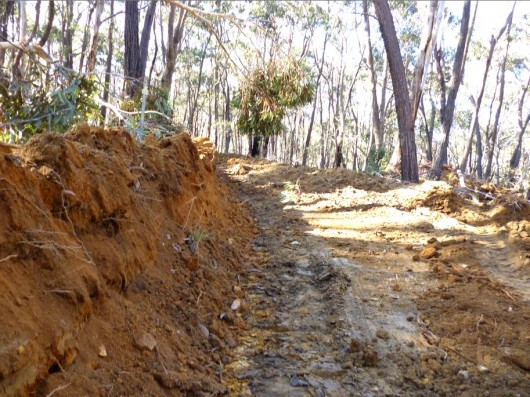 . .
The Aboriginal site destruction and massive Native Flora impact was which committed by a contract road works gang, who where engaged to undertake the works without any impact statements, by Ian Tucker of Oberon Shire Council. The destruction has occurred between Grid Reference 2236590E 6262500N at old Kayangatha Station Ruins and Grid Reference 2269000E 6260600N at the edge of the Pine Forest.
Aboriginal Sites that have been destroyed by machinery are at the following grid references:
.
- Kyangatha Station: 2236590E 6262500N on the right edge of the road 50m North of the cattle grid. Two chert flakes, and one quartz flake
- Mini Mini Saddle: 2235850E 6261700N on the flat cleared ground opposite the un-used cattle grid. Six chert flakes, a direct impact break in one of the flakes from a heavy machine rolling over it
- Alum Creek: 2234900E 6260500N on the Little River side of the road opposite Tree of Heaven cluster. One white chert flake.
.
All sites are comprised of small chert and quartz flake material of varying colours and sizes. The size of the materials vary from 10mm to 50mm. I was led to believe that the site in which heavy rolling machines have rolled over, and broken some of the chert flake pieces, at Mini Mini Saddle was a pre-recorded camp site. This directly breaches Section 90 of the National Parks and Wildlife Act 1974, whether the sites where identified prior to the works or not.
In an undated Archaeological assessment of the Six Foot Track by Hooper and Marloo, which ran numerous predicted modelling of Archaeological significant areas it was interesting to note that the Black Range was mentioned as a possible route to the West from the Megalong and Kanimbla Valleys. The significance of the ridge as a travel path remained un-assessed, although it was noted as a highly likely area for Aboriginal sites. It is also interesting to note that the only two site areas in the West of the Six foot track that where impacted by the recent works, were listed in the article.
.
Why?
.
The unsupervised construction workers called it “routine maintenance”. Crap! Clearly, this is illegal land use development. It is wanton irreverible vandalism of important New South Wales natural and cultural heritage.
 Oberon Man? Oberon Man?
.
It appears the Oberon Council was in a hurry to spend “a big payout from flood relief money” according to one of the construction workers, and that they fast tracked the earth works. They told National Parks and the Six Foot Track Heritage Trust that the works where only minor and would fall under the banner of “routine maintenance“.
But how can flood relief money be connected to converting The Six Foot Track into a two-laned fire trail? Has the funding been misappropriated by Oberon Council?
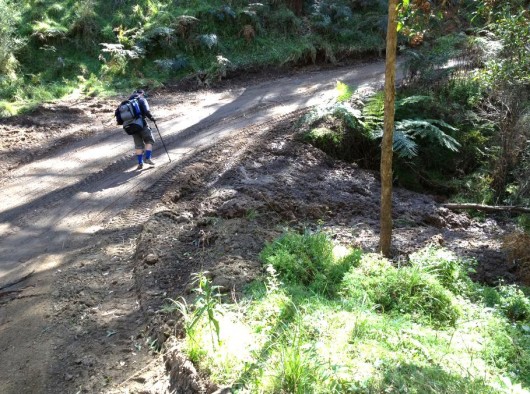 In the past two weeks, many of the so called ‘improvement areas’ have subsequently
returned to their original boggy state even after little to no rain.
This begs the question: Why the works where carried out in the first place? In the past two weeks, many of the so called ‘improvement areas’ have subsequently
returned to their original boggy state even after little to no rain.
This begs the question: Why the works where carried out in the first place?
.
National Parks seem to have agreed with the works, so that they can now drive two fire trucks along it – hooning along a nice wide speedway two abreast.
 You reckon? You reckon?
.
“I feel very hurt, and disheartened by the damage to the Track, and I have many unanswered questions”, says Mr Kelton:
- ‘How can Oberon Council claim that the large amount of impact was only routine maintenance?’
- ‘Why where local Aboriginal Land Council Members not consulted about the impact on potential sites?’
- ‘Why was there no member from National Parks or Aboriginal Lands Council on the ground during the works to assess (supervise) damage?’
- ‘Why where local businesses and tour operators not consulted or informed?’
- ‘Why does National Parks need to drive two fire trucks along the track, as there are no residential properties along the Black Range Road, and fire trucks could not pass each other on any of the long hill sections anyway?’
- ‘Would a more thoughtful, ongoing fire control regimes negate the necessity for emergency fire truck access?’
- ‘Was the impact to local tourism even considered?’
- ‘What will be the safety and aesthetic impact of the widened road for bushwalkers, who share the track?’
.
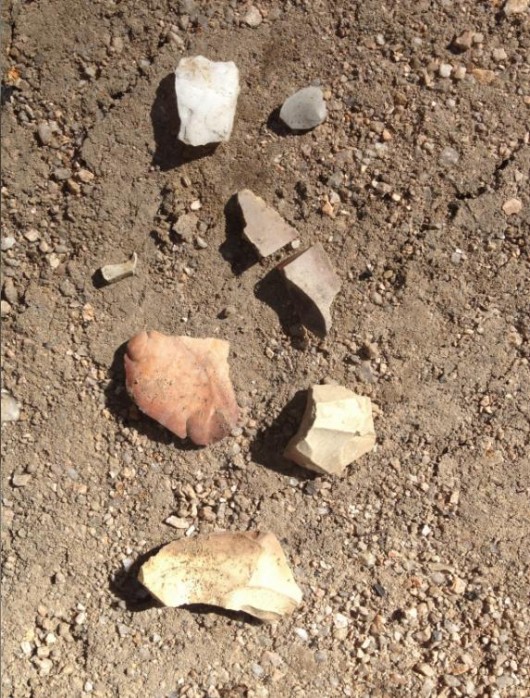 Aboriginal rock implements found along the bulldozed section of the Six Foot Track
Aboriginal cultural sites have been reportedly destroyed
at Mini Mini Saddle, Kyangatha Station and Alum Creek.
. Aboriginal rock implements found along the bulldozed section of the Six Foot Track
Aboriginal cultural sites have been reportedly destroyed
at Mini Mini Saddle, Kyangatha Station and Alum Creek.
.
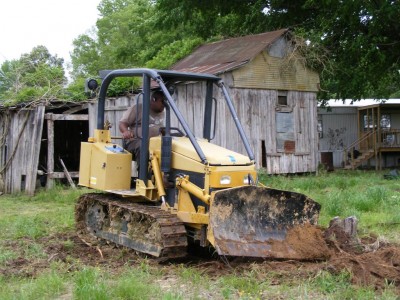 Oberon Man’s Day Off? Oberon Man’s Day Off?
.
History of Government Vandalism to Six Foot Track
.
Destruction to The Six Foot Track is not new. Back in June 2005, the Blue Mountains Bushfire Co-ordination Committee, under the chairmanship of Blue Mountains Councillor Chris Van Der Kley, subcontracted a similar bulldozing of the Nellies Glen section of the Six Foot Track. Again the earth works were unsupervised. Again the earth works caused considerable ecological and riparian damage and again they involved reckless bulldozing through documented Aboriginal sites and cultural heritage – as in the case now, numerous ancient stone implements were discovered disturbed by the trail making works.
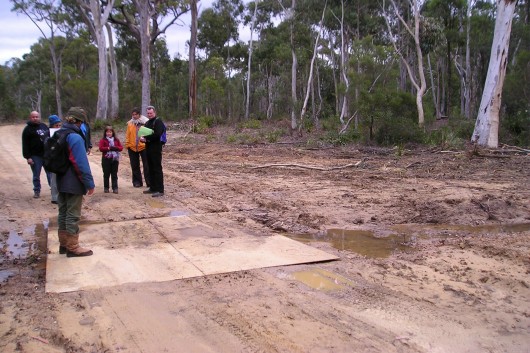 In August 2005, recent bulldozing of the Six Foot Track was inspected
by local Indigenous people and members of the Blue Mountains Conservation Society In August 2005, recent bulldozing of the Six Foot Track was inspected
by local Indigenous people and members of the Blue Mountains Conservation Society
(Photo by Liz Mitchell, 20050814)
.
Subsequent remediation of the works involved a number of stakeholder meetings and the responsibility for environmental remediation was passed from the BM Bushfire Co-ordination Committee to the Blue Mountains Council to fix. The earth works had resulted in significant disturbance of the road verge in several sections along the road. Ultimately the remediation was carried out by a soil remediation consultant through the New South Wales Department of Lands Soil Conservation Service costing $27,000.
The Soil Conservation Service inspected the damage and created a rehabilitation plan and specification for a section of Crown Road and Crown Reserve (Nellies Glen Road and along the Six Foot Track) where fire trail maintenance works were implemented by the Blue Mountains Rural Fire Service.
The majority of the mitre drains installed typically exceeded the recommended amount of fall. Many of the mitre drains have been extended into drainage lines and were already actively eroding. There were several sections of track where mitre drains had been installed and there was insufficient drainage / fall causing water to build up and likely to erode the table drains and / or mitre drains down slope. Several small culverts had been graded over limiting their capacity. There were several sections of track where water flow would likely increase due to the slope and lack of drainage measures. Several creek crossings had been graded over, potentially exposing the creek bed to scour. There was also noted significant clearing and disturbance along the length of the roadside/track.
All sound familiar? Read More: >’Report and Specification for Restoration Works on Nellies Glen Road and the Six Foot Track (Aug 2005) (PDF, 730kb).
The Department of Lands Soil Conservation Service is the New South Wales Government agency to which the custodial Six Foot Track Heritage Trust reports.

Back in 2005, a local Blue Mountains resident, Liz Mitchell, reported her similar shock discovery of recent bulldozing along the Nellies Glen section of The Six Foot Track to this Editor. At the time, this Editor was acting in the capacity as Honorary Director of Colong Foundation for Wilderness. Subsequent investigations were initiated including a walk down The Track to inspect the damage first hand. This Editor wrote the following two articles in the Local Blue Mountains Gazette in the weeks following:
.
Letter #1: ‘RFS Bulldozes Six Foot Track’
.
This is what a bulldozer can do midweek when nobody’s watching. (Ed: See photo above)
The Six Foot (Bridle) Track is a State icon, first negotiated on horseback in 1887 as a shortcut from Katoomba to Jenolan Caves. The track is ‘protected’ under the Central Tablelands Heritage Trust by the Department of Land and Water Conservation. The area holds important Aboriginal cultural value. The Track passes through a significant River Oak Forest vegetation community and the topsoils along this river valley are particularly sandy, and once exposed are highly susceptible to erosion and weed infestation.
RFS choice of contractor has bulldozed the heritage Six Foot Track out to a 66 foot speedway and fresh mitre drains to channel the new runoff problem into Megalong Creek. Once the rains come and the exposed topsoil’s washed into the creek, flat chance the bush’ll come back.
This is not fire trail ‘maintenance’. This is road making. How ‘strategic’ anyway is a track deep in a bush valley over two kilometres from Katoomba? Strategic for arsonists perhaps. Anyone else would need development consent to bulldoze bush – and probably would be rightly rejected. The privileged exemption status granted to the RFS is for times of emergency. It is not a carte blanche for cowboy contractors.
This sad muddy bog left at the Corral Creek crossing is testament to the loose procedural controls of the bushfire committee. Such actions cannot help the RFS’ otherwise high community standing.’
[Source: ‘RFS Under Fire’ (title changed by newspaper), Blue Mountains Gazette, 20050727, Read previous article on The Habitat Advocate: >’RFS Bulldozes Six Foot Track‘]
.
Letter #2: ‘Six Foot Track Abused’
.
‘The June bulldozing or grading of the Six Foot Track near Megalong Creek was not only wrong, unnecessary and excessive; it breached the statutory provisions of the Crown Lands Act 1989 under Crown Lands (General Reserves) Bylaw 2001, which prescribes rules for the Track’s environmental protection, heritage and public recreation.
For instance, By-law 23 (2) (n) prohibits conduct in the reserve involving defacing or removing or disturbing any rock, sand, soil, stone or similar substance. It appears no written consent was provided by the Trustee of the Six Foot Track Heritage Trust to the RFS.
The bulldozing also breached the Six Foot Track Conservation and Management Plan of 1997 (two volumes totalling 279 pages). Section 2.1.1 prescribes the need for ecologically sustainable development principles to be followed for all management and planning associated with the Track. Bulldozing or grading is not ecologically sustainable. Policy Statement (7.2) (d) states that the physical elements of the Track including examples of the original alignment, works and sites of Aboriginal and European significance and remnant stands of vegetation should be retained and conserved wherever possible. Numerous threatened species of flora and fauna are recorded as likely present in the Six Foot Tack environs and are listed in Volume I of the Plan. The Plan also states at Section 8.2.5 that “Where development consent is not required an environmental impact statement should be undertaken where there is likely to be an adverse impact on the environment.”
The Plan proposes the following general management objectives for the Six Foot Track:
- To ensure that all management decisions fully recognise the considerable cultural and heritage significance of the Six Foot Track
- To seek to recover and retain the Track’s original character by the preservation and restoration of identified sites and Track features.’
[Source: ‘Six Foot Track abused’, by Editor, (letter to the editor), Blue Mountains Gazette, 20050831, p.12]
.
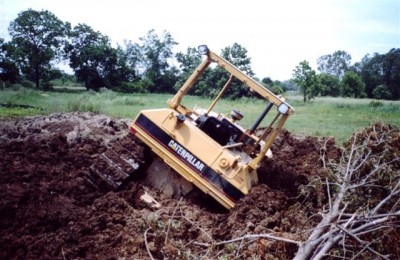 Oberon Man after a big night out? Oberon Man after a big night out?
.
Letter #3: ‘RFS Strategy Misguided’
.
It has been revealed that the June bulldozing or grading of the Six Foot Track near Megalong Creek was a mere drop in the RFS Bushfire Mitigation Programme. Across the Blue Mountains, some twenty natural reserves including the Six Foot Track were targeted under the RFS 2004-05 fire trail strategy – Edith Falls, McMahons Point, Back Creek, Cripple Creek, plus some 95 hectares inside our National Park. According to the federal Department of Transport and Regional Services (DOTARS) website, $151,195 was granted to the RFS in the Blue Mountains alone, bulldozing 144 hectares of bush in the name of “addressing bushfire mitigation risk priorities.”
The Six Foot Track Conservation and Management Plan 1997, Vol II lists numerous vulnerable species of fauna recorded near Megalong Creek – the Glossy Black-Cockatoo (Clyptorhynchus lathami), Giant Burrowing Frog (Heleioporus australiacus) and the Tiger Quoll (Dasyurus maculatus). The RFS contractors wouldn’t have had a clue if they were within 100 metres or 1 metre of rare, vulnerable or threatened species.
The RFS is not exempt from destroying important ecological habitat; rather it is required to have regard to the principles of Ecologically Sustainable Development (ESD). Yet the RFS policy on hazard reduction is woefully loose on the ‘Bushfire Co-ordinating Committee Policy 2/03’ on ESD – advocating protection of environmental values and ensuring that ESD commitments are adopted and adhered to by contractors. Experience now confirms this policy is nothing more than ‘green-washing’.
The critical value of dedicated RFS volunteer fire-fighters fighting fires is without question. What deserves questioning is the unsustainable response of the RFS ‘old guard’ to fire trails and hazard reduction with token regard for sensitive habitat. Repeated bushfire research confirms that bushfires are mostly now caused by arson and that the prevalence of property damage is a result of more residential communities encroaching upon bushland.’
[Source: ‘RFS Strategy Misguided’ by Editor, (letter to the editor), Blue Mountains Gazette, 20051005]
.
Recommendations:
.
The management and conservation of The Six Foot Track is guided by the aptly named ‘Six Foot Track Conservation and Management Plan‘ 1997, which comprises two volumes of a total of 279 pages.
However, on at least two occasions now this plan has been ignored and The Six Foot Track and its surrounding natural habitat and cultural heritage fabric have been extensively vandalised by government contractors. This is unacceptable. Enough is enough. Some organisations are just either slow at learning, or more likely think they are above the law and somehow beyond community accountability.
We make the following recommendations:
- All earth works to be immediately halted along The Six Foot Track
- An immediate inspection of the damage to be made by Department of Lands and stakeholders including local indigenous peoples to be invited to inspect and comment
- Since the NPWS, the Oberon Council or the Trustee of The Six Foot Track can’t be trusted with environmental heritage, the Premier of New South Wales, Mr Barry O’Farrell, should order the Legislative Assembly Committee on Environment and Regulation to conduct a Parliamentary Enquiry with terms of reference to investigate: (1) The extent of the damage to environmental and cultural values caused by the earth works, (2) The extent to which the damage has breached The Six Foot Track Conservation and Management Plan, (3) The custodial failings by the trustee, (4) Whether government flood relief funds have been misused by the Oberon Council, and (5) Make findings and recommendations as to appropriate actions including environmental remediation and appropriate future governance of The Six Foot Track conservation, management and reporting framework and the delegation of its execution.
- Disciplinary action should be taken against NPWS Oberon Area Manager, Kim De Govrik; Oberon Council Engineering Service’s works manager, Ian Tucker; and against the Trustee of the Six Foot Track Heritage Trust, Jon Guyver, or whoever is currently in the role. If they are found responsible for the damage, then they should each be immediately dismissed from their positions and from their respective government employers.
.
Is this the image of Oberon Tourism?
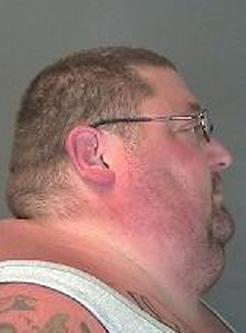 . .
Tags: Aboriginal Sites, Alum Creek, Blue Mountains Rural Fire Service, Bulldozing Six Foot Track, bushwalking, Fire Trail, fire trucks, Kanangra Boyd National Parks Office, Kyangatha Station, Mini Mini Saddle, Montane Peatlands, New South Wales National Parks and Wildlife Service, NPWS, Oberon Council, RFS, Six Foot Track, Spring Gully
Posted in Blue Mountains (AU), Threats from Bushfire, Threats from Road Making | 4 Comments »
Add this post to Del.icio.us - Digg
Sunday, April 1st, 2012
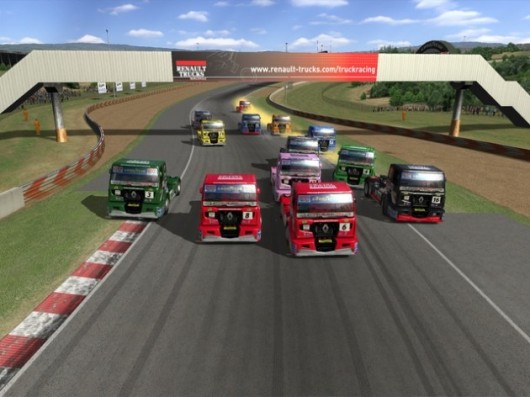 RMS policy: More trucking expressways > bigger faster trucks > more carnage RMS policy: More trucking expressways > bigger faster trucks > more carnage

Mar 2012: ‘Driver fined after allegedly driving b-double truck 30kmh over the speed limit – Mittagong’
[Source: ^http://www.police.nsw.gov.au (media release) ]
.
‘A man has been fined after being stopped by police for allegedly speeding in the state’s Southern Highlands.
About 5.44am yesterday (Monday 5 March 2012), police were patrolling the (6-laned) Hume Highway at Mittagong, when they allegedly detected a white B-double (truck) travelling at a speed of 142kph in an 110kmh zone. They stopped the vehicle a short distance away and issued the 41-year-old male driver with a traffic infringement for exceed speed over 30km/h.
The fine for the offence is $1112.
[Ed: A poultry slap on the wrist fine? When 60+ tonnes is hurtling along the road at 142kph, how is this not attempted murder?]
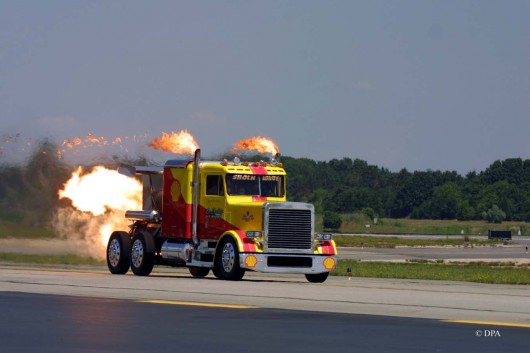 Killer on the Road Killer on the Road
.
Mar 2012: ‘Fatal head-on in NSW’ (south of Oberon)
[Source: ‘Fatal head-on in NSW’, bigpondnews, Saturday, March 31, 2012, ^http://bigpondnews.com/articles/National/2012/03/31/Fatal_head-on_in_NSW_734843.html]
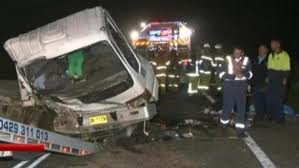
‘A truck driver has been killed, and three men have been airlifted to hospital, after two trucks collided head-on near Oberon, west of Sydney.
Police say the Isuzu table top truck and Mack prime mover logging truck crashed on Abercrombie Road, at Black Springs just before midnight (AEDT).
The Isuzu driver, aged in his 30s, died at the scene. Two other men inside suffered head and chest injuries, while the driver of the other truck, aged in his 60s, has an injury to his leg. Abercrombie Road is expected to remain closed until around 7am (AEDT).’
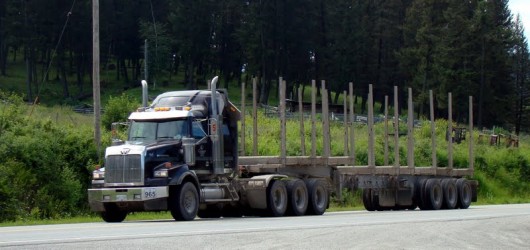 Typical prime mover logging truck (empty) Typical prime mover logging truck (empty)
.
Jul 2009: Recall the fatal truck crash east of Oberon three years ago…
[Source: ‘Man killed in truck crash‘, by Brendan Arrow, Western Advocate, 20090708, ^http://www.westernadvocate.com.au/news/local/news/general/man-killed-in-truck-crash/1561790.aspx]
.
‘One man died and another was airlifted to a Sydney hospital after a car and truck crashed head-on near Oberon yesterday afternoon.
Emergency services received reports about 1.12pm of a car hitting a truck on the Duckmaloi Road near Fearndale Road on the Sydney side of Oberon. Ambulance officers arrived and began treating the men involved in the accident. The passenger of the car was declared dead at the scene.
The 20-year-old male driver of the car was airlifted to Westmead Hospital with multiple fractures to his legs, arms and chest as well as head injuries. The truck driver was assessed by ambulance officers and did not require hospitalisation. Late last night the Duckmaloi Road was still close to non-residential traffic as spilt fuel and debris was cleaned from the site.
An Oberon trucker driver, who wished to remain anonymous, later said the Duckmaloi Road needed to be seriously looked at due to the large amount of traffic it carried.
“Along with the Bathurst road it is one of the two main veins into Oberon,” he said. “I believe around 200 trucks a day would use that road to get from Oberon to Sydney and back again.”
The truck driver added that for people who did not frequently use the Duckmaloi Road it could be very dangerous. “It can be bloody treacherous if you don’t know it,” he said.
“In one day I think we send about 50 trucks out and have 50 trucks come back in on it [the Duckmaloi Road]. “If you also add in the log trucks and the chip trucks than you would easily have 200 trucks a day on that road.”
[Ed: Two years later, $395,000 from the Australia Government went into widening the Duckmaloi Road. ^Read More]
.
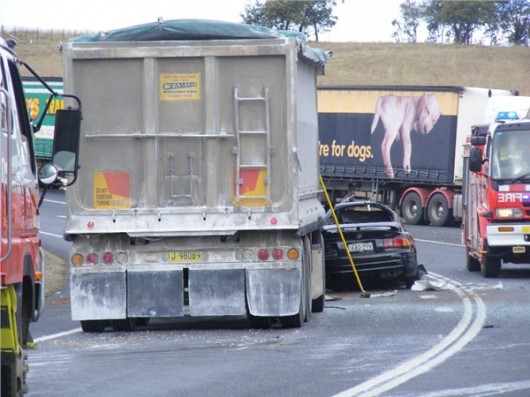 Fatal truck head-on near Oberon, NSW (2009) Fatal truck head-on near Oberon, NSW (2009)
.
2012: Great Western Highway – Wentworth Falls East ‘trucking upgrade’

No 1 Feature: “Widening the highway to four lanes with sealed shoulders“!
No 1 Benefit: “Quicker journeys – in the region and to Sydney“!
 Great Western Highway being widened to a faster 4-lane trucking expressway Great Western Highway being widened to a faster 4-lane trucking expressway
[Source: RMS, ^http://www.rta.nsw.gov.au/roadprojects/projects/great_western_hway/ww_falls/index.html]
.
Mar 2012: ‘Delays at Marulan after truck crash’
[Source: ‘Delays at Marulan after truck crash‘, 20120327, ^http://www.fullyloaded.com.au/industry-news/articleid/78790.aspx]
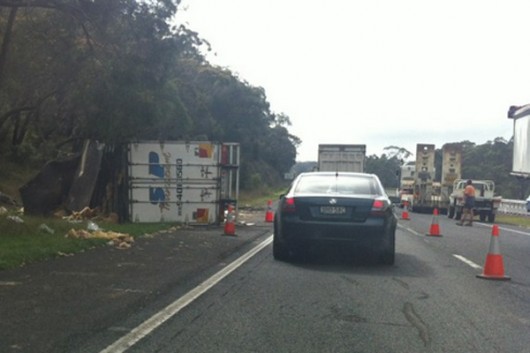 Four laned Hume Highway built for faster, bigger trucks – not safer. Four laned Hume Highway built for faster, bigger trucks – not safer.
.
‘Delays are expected today on a section of the Hume Highway in NSW after a crash involving two trucks near Marulan. NSW Police says a B-double carrying furniture rolled about 5km south of Marulan at 12.45am, spilling its load and blocking all northbound lanes. A semi-trailer travelling behind crashed into the rear of the truck…’
.
Jul 2011: Near the same spot a year before..’Fatal crash near Marulan’
[Source: ‘Fatal crash near Marulan’, by David Butler and NSW Police Media, 20110729, ^http://www.goulburnpost.com.au/news/local/news/general/fatal-crash-near-marulan/2242199.aspx]
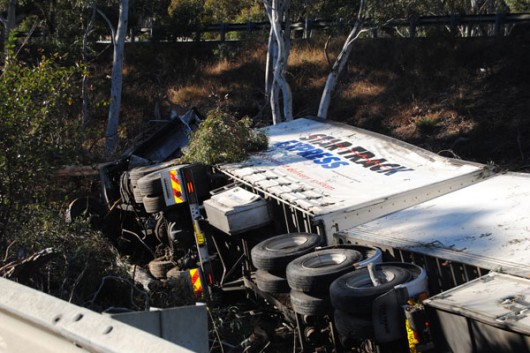 Star Express B-Double crashed solo into this gully just after midnight
The driver’s dead – fell asleep or heart attack at the wheel? Star Express B-Double crashed solo into this gully just after midnight
The driver’s dead – fell asleep or heart attack at the wheel?
.
‘A report will be prepared for the coroner following a fatal highway crash near Marulan in the early hours of the morning.
About 12.45am this morning a B-double truck travelling north on the Hume Highway left the road and plunged into a deep roadside gully, rolling on to its side and taking out trees and a 10-meter section of guard rail in the process. The cause of the crash is still unknown and police investigations are continuing. No one else was injured in the crash.
The driver, a 47-year-old man from Glenfield, suffered severe injuries and died at the scene. He was travelling from Albury to Sydney when the accident occurred approximately 15km north of Goulburn.
[Ed: All night 60+ tonne all night bats out of hell and 60+ tonne all night zombies being driven to death by greedy retailers demanding pre-dawn delivery times. Overnight linehaul is al about unnatural sleep depravation. It is death waiting to happen. Driving on Australian highways aafter midnight has become Russian Roulette death wish to all road users. Meanwhile, Australian Truckers Association chairman David Simon says the government should also be encouraging more “AB-triples” — which are 51m long — and “BAB-quads”, which are two connected B-doubles.” [Read More]
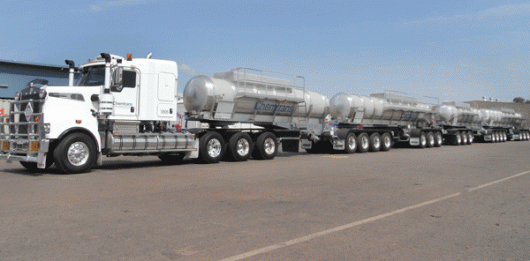 Why have railway tracks, when trucking companies keep adding carriages and ring feeders? Why have railway tracks, when trucking companies keep adding carriages and ring feeders?
.
Mar 2012: B-Double truckers tampering with speed governors
[Source: ‘Police blitz on trucks widens’, by AAP, 20120307, ^http://www.weeklytimesnow.com.au/article/2012/03/07/453455_machine.html]
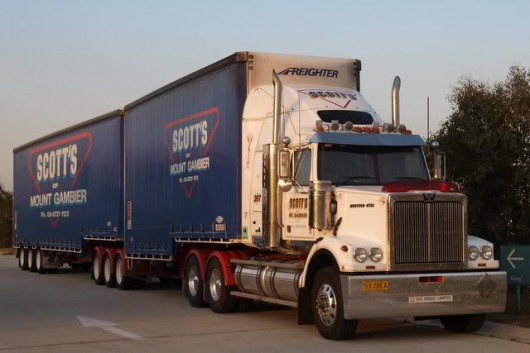 “Faster, faster..you’re a good operator!” “Faster, faster..you’re a good operator!”
.
‘New South Wales police have seized two South Australian trucks as part of a crackdown on unsafe practices in the road transport industry. Officers in NSW had intercepted 13 trucks from Scott’s Transport Industries as of today in a nationwide blitz on the Mt Gambier-based firm, which operates a fleet of 322 trucks and is suspected of serious safety breaches.
NSW police launched Operation Overland after one of the company’s B-doubles was detected travelling at 142kph on Monday.
An analysis of the company’s trucks’ movements has shown speeding by 32 of them.
Superintendent Stuart Smith said the two trucks were stopped after being identified as having defects, but it was too early to say if the defects were the result of tampering.
He said more of the company’s vehicles would be targeted for interception and comprehensive mechanical inspections.
“It’s not the 300, but it’s a large number,” Superintendent Smith said. “There’s a large number to go and the operation will continue for a number of days.”
Further actions by NSW Roads and Maritime Services will likely lead to a prosecution and significant fines.
Premier Barry O’Farrell said transport companies had been warned checks would become more regular. “Trucking companies should understand that what was then unprecedented action would become more regular if we had suspicions that there were cowboys driving trucks across the state’s roads, that it was likely to cause safety concerns for motorists,” Mr O’Farrell told reporters in Sydney.
Police have said an investigation of Lennons Transport Services, based in Sydney’s inner west, found eight trucks had been tampered with, including seven that had been modified to exceed the maximum speed of 100km/h. They have also charged a Lennons’ driver with dangerous driving causing the deaths of three members of one family on January 24.
Calvyn Logan, 59, and his elderly parents Donald and Patricia Logan, in their 80s, were killed when a Lennons‘ B-double truck careered onto the wrong side of the Hume Highway, near Menangle in southwest Sydney.
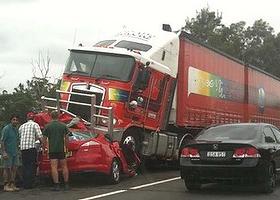 B-double truck driver Vincent Samuel George (33) killed three members of one family with his B-Double.
Court records also revealed that between 1998 and last year, George had his licence suspended five times and he has been convicted of 17 offences, including speeding and drink driving.
[^http://www.truckinlife.com.au/articles/2012/truck-collision-menangle-bridge]
B-double truck driver Vincent Samuel George (33) killed three members of one family with his B-Double.
Court records also revealed that between 1998 and last year, George had his licence suspended five times and he has been convicted of 17 offences, including speeding and drink driving.
[^http://www.truckinlife.com.au/articles/2012/truck-collision-menangle-bridge]
.
Police allege the driver’s truck had been tampered with to make it go faster.
.
The RMS has also filed a series of summons in the NSW Supreme Court relating to driver fatigue at South Penrith Sand and Soil.

RMS alleges a series of offences relating to drivers’ work hours, rest hours and fatigue management. A cyclist was killed and three were injured after a truck driver working for the company veered into a breakdown lane and hit them on the M4 motorway on April 10, 2010.
The driver pleaded guilty last week to manslaughter.
 Sydney’s M4: this is supposedly an RMS cycle lane Sydney’s M4: this is supposedly an RMS cycle lane
.
Recall, RMS ‘upgrade features‘ at its Great Western Highway Wentworth Falls East section include:
“Improved cyclist access and safety – access for commuter and long distance cyclists will be provided by a 2.5 metre shoulder between Nelson and Dalrymple avenues.”
[Source: ^http://www.rta.nsw.gov.au/roadprojects/projects/great_western_hway/ww_falls/features_benefits.html]
.
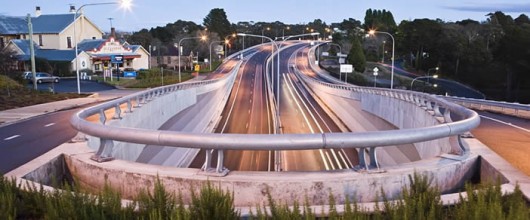 Try riding a bicycle through the Leura section, just up the Great Western Highway from Wentworth Falls
Spot the cycle lane…Russian Roulette anyone?
. Try riding a bicycle through the Leura section, just up the Great Western Highway from Wentworth Falls
Spot the cycle lane…Russian Roulette anyone?
.
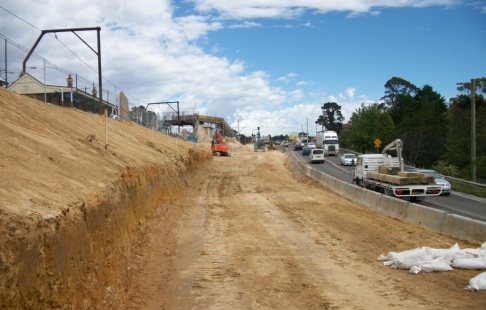 Great Western Highway – being transformed into a trucking expressway
so that bigger and more trucks can travel faster, all night long.
.
Trucking Expressways are the antithesis of road safety Great Western Highway – being transformed into a trucking expressway
so that bigger and more trucks can travel faster, all night long.
.
Trucking Expressways are the antithesis of road safety
.
.
Mar 2012: ‘Twelve more trucks had speeds tampered’
[Source: ‘Twelve more trucks had speeds tampered‘, SkyNews, 20120310, ^http://www.skynews.com.au/local/article.aspx?id=727226&vId=]
.
Another 12 trucks have been discovered with tampered speed limiters during a two-state police probe into dodgy practices (Ed: read ‘criminally culpable‘) in the industry.
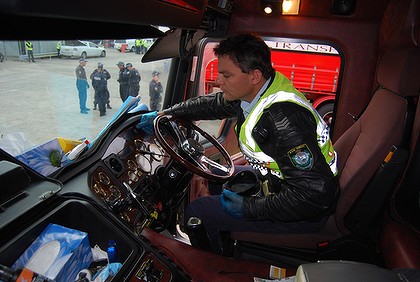 Police inspecting Lennons Transport Services B-Double truck
Police inspecting Lennons Transport Services B-Double truck
.
‘Operation Overland’
Operation Overland was launched into Scott’s Transport Industries on Monday. Ninety-eight of the South Australian transport company’s fleet of 322 heavy vehicles have since been intercepted for mechanical inspection.
On Thursday, police said they had found six trucks with tampered speed limiters. A day later, 12 more had been discovered, taking the total to 18.
Overall, 71 offences have been identified, including two trucks found to be overloaded.
Almost 70 defect notices have been issued. The probe into Scott’s Transport Industries began after one of its drivers was clocked travelling at 142km/h on the Hume Highway at Mittagong about 5.45am (AEDT) on Monday.
.
Earlier this year, police swooped on Lennons Transport Services, in Sydney’s inner-west, where they discovered eight tampered trucks, including seven modified to exceed the 100km/h maximum.
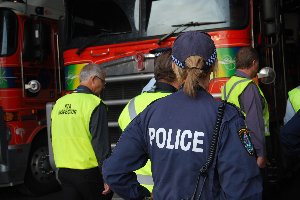 Police Blitz at Lennons Transport Services Police Blitz at Lennons Transport Services
.
It came after a Lennons driver was charged with dangerous driving causing the deaths of Calvyn Logan, 59, and his elderly parents Donald and Patricia Logan, in their 80s.
The truckie’s B-double allegedly careered onto the wrong side of the Hume Highway near Menangle and crashed into the trio’s car.
.
Feb 2011: ‘Man dies after trucks collide on Hume Freeway, Baddaginnie’
[Source: ‘Man dies after trucks collide on Hume Freeway, Baddaginnie‘, by Jessica Craven, Herald Sun, February 15, 20110215, ^http://www.heraldsun.com.au/news/more-news/man-dies-after-trucks-collide-on-hume-freeway-baddaginnie/story-e6frf7kx-1226006057102]
.
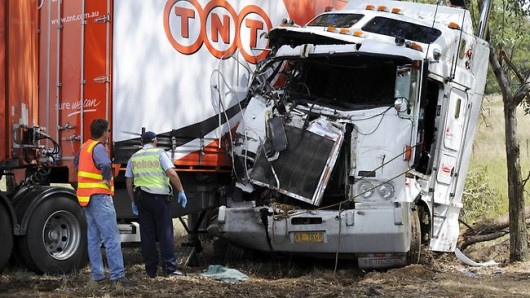 Six-laned Hume Freeway – the wider and faster the expressway…
All night trucking zombies
[Photo: Jon Hargest, Herald Sun] Six-laned Hume Freeway – the wider and faster the expressway…
All night trucking zombies
[Photo: Jon Hargest, Herald Sun]
.
‘A man has died following a collision between two trucks on the Hume Freeway in Baddaginnie (Ed: Victoria, just south of the NSW border) just after midnight.
It’s believed one driver lost control of his truck which rolled onto the freeway moments before a second truck collided with it at 12.08am.
The driver of the second truck died and police are investigating the cause of the collision. The identity of the dead man is yet to be established.
The Hume Freeway is closed northbound at Violet Town and diversions are in place.’
.
Comments:
Patrick of Rooney (20110215):
“Wake up and sip the coffee Victoria! We need thousands more speed cameras out there!”
.
Andrew of Flemington (20110215):
“Worksafe Victoria, where are you?? Another tragic death caused by unsafe work practices. How many more deaths and injuries must occur before you finally step in?
.
Feb 2011: ‘Logging truck driver kills car driver stopped at traffic lights outside Bathurst’
[Source: ‘One killed in truck crash‘, by Jo Johnson, Western Advocate, 20110201, ^http://www.westernadvocate.com.au/news/local/news/general/one-killed-in-truck-crash/2062626.aspx]
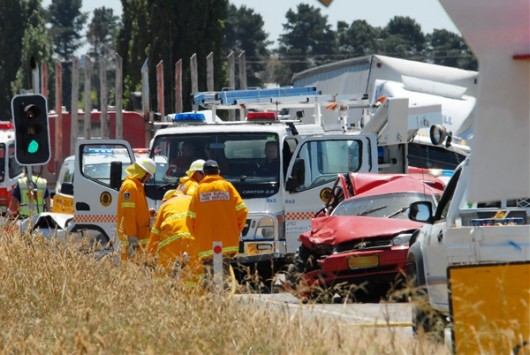 Media news often doesn’t travel outside one’s local area,
so other Australians don’t realise the extent of the trucking carnage being inflicted across the country.
.
Who says truck drivers are ‘professionals’? Media news often doesn’t travel outside one’s local area,
so other Australians don’t realise the extent of the trucking carnage being inflicted across the country.
.
Who says truck drivers are ‘professionals’?
.
‘A 59-year-old local man is dead and two others seriously injured after a truck ploughed into three cars stopped at roadworks traffic lights on the O’Connell Road yesterday. The tragedy occurred at lunchtime, about 15 kilometres south of Bathurst.
Emergency services rushed to the scene to find people trapped in their cars. The road was immediately closed to traffic in both directions. Initial investigations have revealed that an unladen logging truck struck the vehicles, which were all making their way towards Bathurst at the time.
Police, ambulance and fire and rescue crews were called to the crash site at about 12.30pm. An air ambulance helicopter landed on the road near the accident to provide additional assistance.
Bathurst police Inspector Ross Wilkinson confirmed the driver of a red Toyota Camry died at the scene. He was a 59-year-old male from the O’Connell region.
The logging truck was travelling north when it slammed into the rear of the Toyota Camry, killing the man and seriously injuring a female passenger.
The driver of the next car in line, a silver Mazda Astina, was also in a serious condition yesterday afternoon, while the driver of a bronze Holden Rodeo was taken to Bathurst Base Hospital for observation.
Inspector Wilkinson said Chifley Local Area Command’s crash investigation unit attended the scene and investigations into the fatality would continue. The driver of the logging truck was uninjured and is helping police with their inquiries.
Traffic was diverted via Brewongle and The Lagoon and drivers heading to Oberon from Bathurst late yesterday afternoon were advised to divert at Hartley via Jenolan Caves Road.
The roadworks were being carried out by the NSW Roads and Traffic Authority (Ed: recently rebranded ‘RMS’) , between the Wests Lane turn-off to Brewongle and Ridge Road.
.
Feb 2010: ‘Speeding B-Double Blayney Cattle Truck Rolls Over – kills/maims 21 cattle’
[Source: ‘Speeding B-Double Blayney Cattle Truck Accident 2-6-2010‘, by Clare Colley, 20100603, ^http://www.canobolas.rfs.nsw.gov.au/dsp_content.cfm?cat_id=131092]
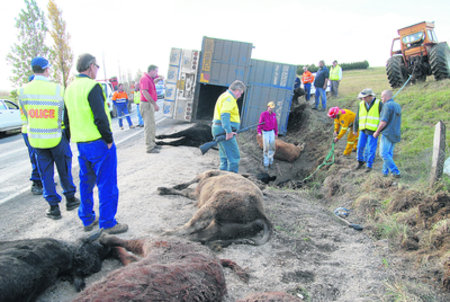 Injured cattle shot after speeding cattle truck overturned on bend near Blayney (Central NSW) Injured cattle shot after speeding cattle truck overturned on bend near Blayney (Central NSW)
.
Traffic between Blayney and Bathurst was detoured through Millthorpe yesterday after a semi-trailer cattle truck overturned while negotiating a sharp left bend about three kilometres out of Blayney.
Drivers on the Mid Western Highway had to slow to avoid runaway cattle after the accident on the outskirts of Blayney shortly after 11am.
Inspector Ross Wilkinson from Chifley Area Command said that police were continuing their investigations into the cause of the accident that disrupted highway traffic for four hours and killed 21 of the 96 cattle on board the truck.
“Police will issue an infringement notice to the truck driver at a later stage,” he said. “It’s a timely reminder for drivers to take care when driving in the changing weather conditions.” [Ed: Yet another dangerous coyboy truckie gets but a slap on the wrist. The driver deserves a custodial sentence for recklessly causing pain and suffering to the cattle, and barred from cattle truck driving for life].
.
The road between Bathurst and Blayney was closed for 30 minutes while cranes were brought in to lift the truck back onto the road. RTA workers, who were among the first at the accident scene, began directing traffic and slowing motorists down to avoid the cattle before police arrived.
“We’ve been trying to keep things flowing,” one RTA worker said. “A couple of steers got away but they’ve pretty well got them under control.”
Blayney Shire Council overseer, Paul Wade, said that Blayney Shire Council staff were working with the RTA to divert Bathurst bound traffic through Millthorpe. Mr Wade said that council staff worked with the emergency services and the truck’s driver to help control the traffic and move the surviving cattle into a nearby paddock. The council’s ranger euthanized a number of cattle at the scene…
Yesterday’s accident is the second time a semi-trailer has overturned on the same winding stretch of road on the outskirts of Blayney in recent months. On January 28 traffic on the highway was disrupted for four hours when a semi-trailer travelling towards Blayney overturned while negotiating a left bend near yesterday’s accident scene.
Play Video (Prime News):
 Click image to play video
(when running, double click on video to enlarge)
NB. The Rural Fire Service at Canobolas have since deleted the above video, so here is one from Channel 9: Click image to play video
(when running, double click on video to enlarge)
NB. The Rural Fire Service at Canobolas have since deleted the above video, so here is one from Channel 9:

.
Oct 2010: ‘Truckie’s death adds to road toll’
[Source: ‘Truckie’s death adds to road toll’, by Dominic Zietsch, Daily Examiner, 20101004, ^http://www.dailyexaminer.com.au/story/2010/10/04/truckies-death-horrific-road-toll/]
 All night truck driving solo – another dead truck driver
The driver of this B-Double was killed when it hit an embankment on the Pacific Highway near Corindi (Ed: north of Coffs Harbour) on Friday night
[Photo by Frank Reward] All night truck driving solo – another dead truck driver
The driver of this B-Double was killed when it hit an embankment on the Pacific Highway near Corindi (Ed: north of Coffs Harbour) on Friday night
[Photo by Frank Reward]
.
A man was killed in an horrific crash near Dirty Creek, west of Corindi, on Friday night in what is amounting to a horror weekend on NSW roads.
A B-Double being driven by the 48-year-old man, from Queensland, had been travelling south on the Pacific Highway when it appears to have left the road and crashed into an embankment.
According to a police statement, police and emergency services were called to the crash just after 11pm where the driver, the sole occupant of the truck, had suffered serious injuries and died at the scene. According to the statement, the impact of the crash had detached the two trailers from the prime mover, but no further details were available last night…
This crash adds another death to the mounting NSW road toll with the number rising to eight since the start of the long weekend, five more than for the same long weekend last year.
 . .
Mar 2007: Hume Highway again.. ‘head-on truck crash kills driver’
[Source: ‘Head-on truck crash kills driver‘, Sydney Morning Herald, 20070316, ^http://www.smh.com.au/news/national/headon-truck-crash-kills-driver/2007/03/16/1173722699803.html]
 B-Double Head On – after driving all night? B-Double Head On – after driving all night?
.
A fatal truck crash has closed the Hume Highway near Coolac, in southern NSW. Two trucks collided head-on on the highway, sparking fires in both cabs, about 6.15am (AEDT) today, police said. The driver of a semi-trailer, carrying groceries north on the highway, died at the scene after rescue efforts failed to save him. The driver of a southbound truck, carrying metal, escaped with minor injuries…
.
Ed: The Truck Menace is blatantly out of control. ‘Industry self-regulation’ never works and is nothing but a costing cutting government cop out. Meanwhile Australian Liberal Labor governments continue to pour billions of taxpayers’s money into building bigger and faster dedicated trucking expressways. And so the trucks get bigger and faster and Australia’s highway carnage of families continues unabated…
.
Watch video:
(includes sound)
.
http://www.youtube.com/watch?feature=player_detailpage&v=dvH3XnSNE9s
.
.
Postcript:
.
Well we didn’t have to wait bloody long. The day after posting this article there was another B-double multiple fatality…dead driver, dead and maimed cattle under his care…
.
Speeding truckie hooning a fully laden B-Double cattle truck, loses it on bend – kills himself and the cattle
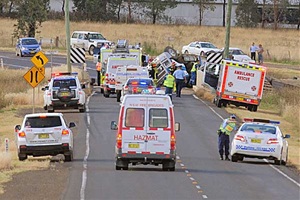 Carnage at Tangaratta Creek yesterday Carnage at Tangaratta Creek yesterday
.
[Source: ‘Truckie killed: B-double rolls near Tamworth‘, by Haley Sheridan, Northern Daily Leader newspaper, 20120403, ^http://www.northerndailyleader.com.au/news/local/news/general/truckie-killed-bdouble-rolls-near-tamworth/2509357.aspx]
.
‘A salvage operation continued into last night to remove a laden cattle truck that crashed into the Tangaratta Creek Bridge near Tamworth yesterday, claiming the life of the driver.
Oxley Highway was closed for hours as emergency crews worked at the scene, first freeing the driver’s body from the truck’s cabin, which had been crushed against the bridge pylons, and then removing dead cattle and the truck from the scene.
An unknown number of cattle were killed or injured and diesel fuel from a ruptured fuel tank leaked into the creek. [‘”65 head of cattle ‘..according to SkyNews ^http://www.skynews.com.au/topstories/article.aspx?id=735717&vId=]
The B-double truck left the road and rolled at the bridge on the Oxley Highway, about 10km west of the city, about 3pm. Police believe the truck was travelling south, bound for Cargill abattoir at Tamworth, when it lost control on a sweeping bend that has been the scene of other serious accidents over the years. [Sky News: Police said the vehicle failed to negotiate a right-hand bend near Tangaratta Bridge, causing it to roll down an embankment.]
An off-duty police officer was first on the scene.
.
Police officers euthanased distressed cattle that had been crushed or injured in the trailers, which rested on their sides near the creek.
.
Oxley Local Area Command duty officer, Inspector Jeff Budd, said the recovery effort was expected to continue late into last night. He said firefighters had set up booms to contain the diesel spill in the creek.
…Yesterday’s fatal crash happened at the same bridge where a horrific bus accident occurred on January 5, 1992, claiming the lives of five people. A double-decker Pioneer bus en route from Brisbane to Melbourne slammed into the bridge on a Saturday night. The crash claimed the lives of an eight-year-old girl, as well as three women and a man.
Inspector Budd said police were continuing their investigations into the cause of yesterday’s crash and a report would be prepared for the coroner.’
.
Meanwhile pig carcasses have been scattered over a motorway in Sydney’s southwest after two trucks collided early today. Police say the heavy vehicles crashed shortly after 2am on the M7 westlink motorway at Prestons, near the Bernera Road off-ramp. The truck carrying the pig carcasses rolled, throwing the meat all over the road.
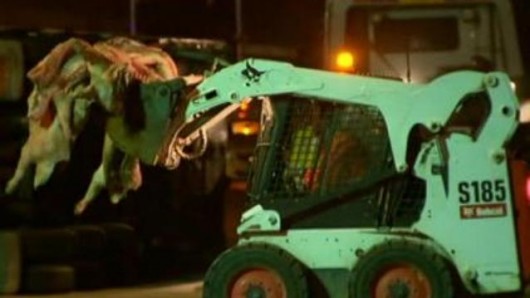 Pig carcasses picked up off M7
http://www.skynews.com.au/national/article.aspx?id=735802&vId= Pig carcasses picked up off M7
http://www.skynews.com.au/national/article.aspx?id=735802&vId=
.
[Source: ‘Driver, dozens of cows die in truck crash‘, 20120403, ^http://www.smh.com.au/nsw/driver-dozens-of-cows-die-in-truck-crash-20120403-1w9ba.html]
.
Tags: All night truck driving, All night trucking zombies, Blayney, cattle truck, dangerous driving causing the deaths, Great Western Highway, Great Western Highway development, Hume Highway, road toll, Roads and Maritime Services, Roads and Traffic Authority, RTA, Truckie's death, trucking expressway
Posted in Blue Mountains (AU), Threats from Road Making | 4 Comments »
Add this post to Del.icio.us - Digg
Tuesday, March 6th, 2012
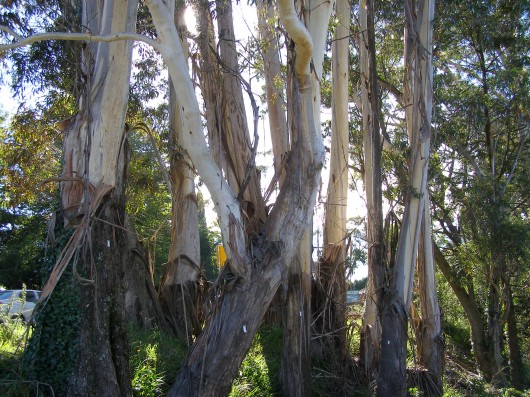 One of the few remaining clusters of mature Blue Mountains Ash (Eucalytus oreades)
endemic to the Upper Blue Mountains
[They are listed on BMCC’s Significant Tree Register
..including the dozen or so killed to widen the highway] One of the few remaining clusters of mature Blue Mountains Ash (Eucalytus oreades)
endemic to the Upper Blue Mountains
[They are listed on BMCC’s Significant Tree Register
..including the dozen or so killed to widen the highway]
.
What a steaming crock Blue Mountains Council’s (BMCC) Significant Tree Register is!
The 73 listed trees or listed tree communities on BMCC’s register listed as ‘significant‘ means exactly what? ‘BMCC significant’ is a lying euphemism for ‘big‘ and ‘expendable‘, confirmed by the fact that every time anyone wants to kill one of the listed trees, they can.
The ‘Register‘ should be renamed a ‘Remnant‘, reflecting the reducing remnancy of the Blue Mountains forests under the control of BMCC.
And many trees on the Register are indeed exotic, if not weeds. For instance, listed tree #3 is an exotic Rhododendron, #18 is an exotic cherry tree, #28 is a Radiata Pine – a listed environmental weed in another department of BMCC.
BMCC’s Significant Tree Register?
.
BMCC’s Significant Tree Register dates back to 1988, probably because of Australia’s bicentennial heritage goodwill of that year, and the likelihood of BMCC getting grant recognition for its register. That would have been a purely political froth event of no substance nor perpetuity.
‘This Development Control Plan has been prepared pursuant to Council’s resolution of 17th November, 1987 and was adopted on 21st June, 1988. The Plan encompasses the Register of Significant Trees, established in 1984. (BMCC File 7717C-4)…This Development Control Plan is to apply to all land within the boundaries of the City of the Blue Mountains.’
.
Objectives of Significant Tree Register
.
The purpose of this Development Control Plan is to:
(a) identify and protect those trees listed on the Register;
(b) promote greater public awareness of the existence of the Register, and the individual items listed;
(c) ensure existing and, importantly, prospective land owners, are made aware of the Significant Trees which may be located on their property; and
(d) ensure correct on-going care and maintenance of those trees listed, through the recommendations included with the significant tree register.’
What disingenuous lying crap!
(a) None of the listed trees is afforded any legal protection. Worse, BMCC does not raise a finger to expend effort or cost to challenge anyone wishing to kill any of the listed trees.
(b) Since 1988, BMCC has done diddly squat to promote any public awareness of either its register or any of its listed trees. Yet, BMCC certainly has killed a few of them. The last time a tree was added to the register was 1991, reflecting the three year extent of Council’s interest, memory and planning,
(c) see (a)
(d) I challenge BMCC to present any record of any “on-going care and maintenance of those trees listed”. Obviously this object clause was drafted by a naive external consultant.
.
Listed Trees – Cases in Point
.
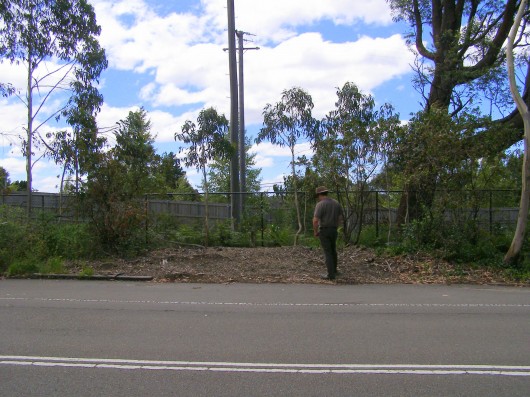 #5 Blue Mountains Ash
(Eucalyptus oreades) #5 Blue Mountains Ash
(Eucalyptus oreades)
(Opposite 252 Old Bathurst Rd. Katoomba Opposite Lot 2 DP707, listed 6.5.84, since chainsawed)
.
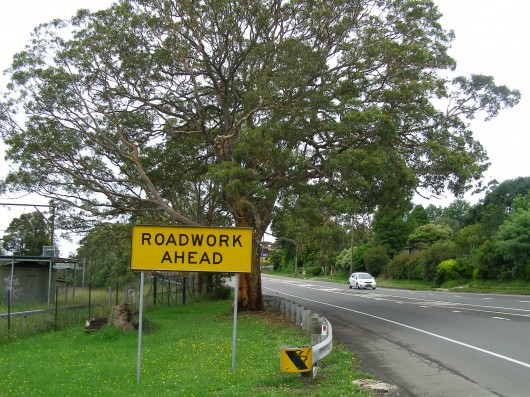 #29 Smooth Barked Apple, Red Gum
(Angophora costata)
(Opposite 363 Great Western Highway, Bullaburra, opposite Lot 173, DP13407, Listed 17.7.85,
condemned by the Roads & Traffic Authority in September 2008 to widen the highway into a 4 laned Trucking Expressway) #29 Smooth Barked Apple, Red Gum
(Angophora costata)
(Opposite 363 Great Western Highway, Bullaburra, opposite Lot 173, DP13407, Listed 17.7.85,
condemned by the Roads & Traffic Authority in September 2008 to widen the highway into a 4 laned Trucking Expressway)
.
New South Wales Government sentence imposed upon this Angophora:
.
“The Angophora (Sydney red gum) tree: the large tree is situated to the east of Boronia Road.
To retain the Angophora tree the highway would have to be widened either towards the railway line or the private properties. In both cases, land would have to be acquired, either from RailCorp or private land owners. The tree’s overhanging branches would have to be trimmed and there would be construction activities around the tree.
Arborist advice is that the consequent loss of tree roots and the pruning would instigate the decline of the tree. Angophora are highly sensitive to construction impacts such as changes to draining patterns and soil compaction. For road construction and safety reasons the tree will have to be removed.”
[Source: ‘Great Western Highway Upgrade – Community Update September 2008, ‘Bullaburra East – Ridge Street, Lawson to Genevieve Road Bullaburra, by Roads and Traffic Authority]
.
Ed: Well, humans can find ways of justifying anything when it suits them – ecological destruction, genocide, wars, anything. Governments and road making organisations like the RTA are collectives of people with mandates that are self-serving.
The RTA (since rebranded) does not have to widen the highway through Bullaburra. It is only doing so to encourage greater truck and car traffic and so that such road traffic can flow faster. Bigger and more roads is the mandate for this road maker. The tradition of slowing down through local towns and villages has been dismissed. Utilitarian convenience is supplanting local rights and values. Other options have been deliberately ignored such as upgrading rail freight logistics and public transport (the rail runs adjacent to and follows the same route as this highway). Land acquistion is an easy process for the RTA. It’s management is just choosing not to take this option because it sees no value in the tree nor in Bullaburra’s amenity.
The tree’s overhanging branches would not have to be trimmed and construction activities could be well away from the tree, if the RTA management so choosed.
The RTA’s standard justification “safety reasons” had to be the clincher. the RTA relies on the ‘safety justification’ as its fallback to get its way, because it has convinced that no-one can reasonably challenge such a justification. That the M4 Motorway with its six lanes has become one of the most deadly RTA roads in New South Wales does not seem to trouble the RTA sufficiently to invest in making the M4 safer. The RTA is hypocritical about road safety.
The value of encouraging faster and bigger trucks and more cars to race through Bullaburra at 80+kph is more important to it than conserving some tree. That this particular tree has been dated by a specialist arborist as being older than300 years and so would have stood when the Three Explorers first crossed the Blue Mountains in 1813, is dismissed as worthless by the RTA and the New South Wales Government. Labor and Liberal are no different in this world view of ‘progress’. Bullaburra is set to be transformed into a Blaxland with bigger trucks racing through it. Bullaburra will become even more divided that what it is now.
If this tree were a war cemetery, there is no question that the cemetery value would be respected and a trucking expressway would not be carved through it.
.
 Les Wielinga
NSW Roads and Traffic Authority Chief (2006-2012)
Executioner of Bullaburra’s Angophora
and Strategic Planner of the Trucking Expressway juggernaut through the Blue Mountains Les Wielinga
NSW Roads and Traffic Authority Chief (2006-2012)
Executioner of Bullaburra’s Angophora
and Strategic Planner of the Trucking Expressway juggernaut through the Blue Mountains
.
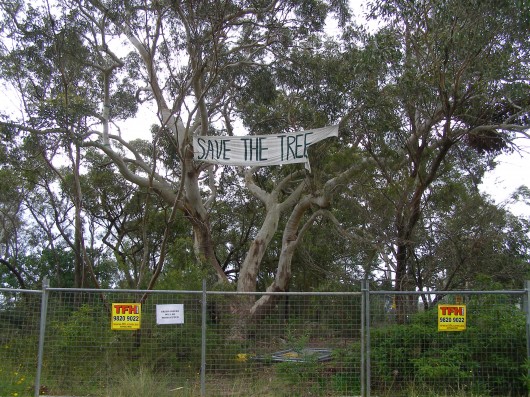 #33 Scribbly Gum
(Eucalyptus sclerophylla/Eucalyptus piperita hybrid)
(Cnr St Georges Cres. & Adeline St. Faulconbridge, Lot 5 DP8526 , Listed 24.8.85,
condemned in Sep 2011 for selfish dual occupancy housing development) #33 Scribbly Gum
(Eucalyptus sclerophylla/Eucalyptus piperita hybrid)
(Cnr St Georges Cres. & Adeline St. Faulconbridge, Lot 5 DP8526 , Listed 24.8.85,
condemned in Sep 2011 for selfish dual occupancy housing development)
.
Blue Mountains Council arborist has condemned the tree as having ‘extensive decay’.
.
Trial by Ordeal?
.
Local residents protesting to save the tree, believe this native Scribbly Gum to be quite healthy and that the arborist’s so-called ‘decay‘ is in fact a natural fungus. The residents believe that Council’s arborist’s assessment has incorrectly condemned the tree and that only after the tree trunk is chainsawed will the proof of the tree’s health be revealed.
It will be akin to being a Medieval Trial by Ordeal imposed on those suspected of being a witch. An example is where a priest would demand a suspect to place his hand in the boiling water. If after three days, God had not healed his wounds, the suspect was guilty of the crime.
In the case of this Scribbly Gum, if after chainsawing it, the trunk shows no signs of internal decay, then it can be confirmed as having being healthy, but by then it will be dead.
.
The Council’s assessment:
“It should also be noted that the significant tree has been assessed as not being viable for retention in any case as the result of extensive decay throughout the trunk. This matter is discussed in more detail in the body of the report.”
[Source: Blue Mountain Council, Business Paper, Using Land for Living Item 20, Ordinary Meeting, 20110628, Development Application No. X/443/2010 for a detached dual occupancyconsisting of a singe storey dwelling and a two storey dwelling on Lot 5 SEC. 2 DP 8526, 47 St Georges Crescent, Faulconbridge, File No: F06738 – X/443/2010 – 11/85977, Clause 44, p.214]
.
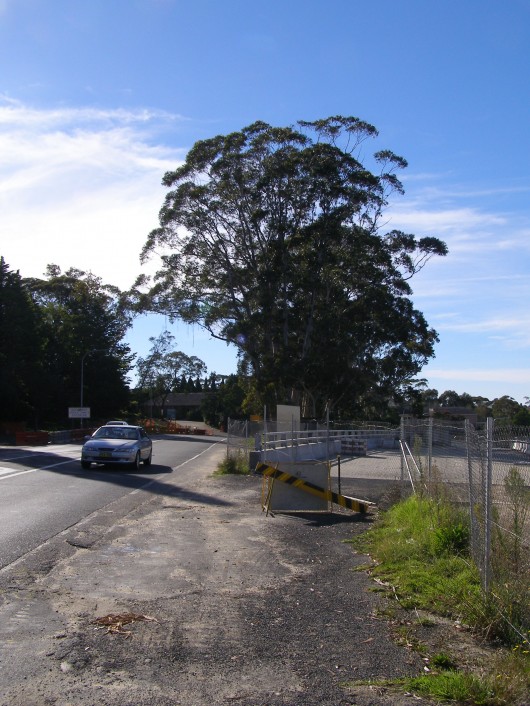 #61 Blue Mountains Ash #61 Blue Mountains Ash
(Eucalyptus oreades – once was a ridgetop forest)
(Railway Reserve opposite Katoomba Hospital, Listed 6.11.89,
half the trees chainsawed in 2008 to widen the highway into a Trucking Expressway.
What’s left is a token coppice so that the RTA can claim on paper that it respected the ‘significant’ status.)
.
Relevance and future of the Significant Tree Register
.
In November 2011, Blue Mountains Councillor Janet Mays presented a Notice of Motion to Council:
.
“That the Council receives a report detailing the role and relevance of Council’s Significant Tree Register, including the cost of both managing and maintaining that Register.”
Background
The recent decision by the Land & Environment Court, to uphold an appeal by the applicants at 47 St Georges Crescent, Faulconbridge, includes permission to remove a tree that is listed on Council’s Significant Tree Register that decision brings into question the relevance of this Register.
The report should outline the role and relevance of the Register in providing decision-making capability to Council’s Planning Officers. The role and relevance of the Register should then be considered in terms of benefits and cost of maintaining this Register. Dependant on the benefits and the costs, the future utility of the Register should also be discussed.”
[Source: Blue Mountains Council, Business Paper, Notices of Motion, Item 26, Ordinary Meeting, 20111122, Subject: Council’s Significant Tree Register, File No: F06745 – 11/178956, p.173]
.
Ed: Meanwhile, anthropocentric prejudice sees the National Trust of Australia (an organisation supposedly committed to promoting and conserving Australia’s indigenous, natural and historic heritage) recognise people as ‘National Living Treasures’. No thought is given to Australian native trees, many which have stood longer than any colonist set foot on Australian soil. Surely, a 300+ year old native tree has more claim to being a national living treasure.
On 4 March 2012, two days ago, we hear that Queensland mining magnate Clive Palmer has been named a National Living Treasure. Palmer has made is fortune exploiting Australia’s landscape for his personal gain. Clearly, Australian Governments continued to be dominated by 20th Century Baby Boomer exploitative world views.
.
Further Reading
.
[1] Blue Mountains Council Register of Significant Trees (1988), ^ http://www.bmcc.nsw.gov.au/download.cfm?f=28AD1E14-423B-CE58-AD64F47560FC3345, [ Read Register]
.
Tags: Angophora, Blue Mountains, Blue Mountains Ash, Blue Mountains Council, Blue Mountains Significant Tree Register, Bullaburra, Eucalyptus oreades, Great Western Highway, National Living Treasure, Scribbly Gum
Posted in Blue Mountains (AU), Threats from Development, Threats from Greenwashing, Threats from Road Making | 2 Comments »
Add this post to Del.icio.us - Digg
Wednesday, February 22nd, 2012
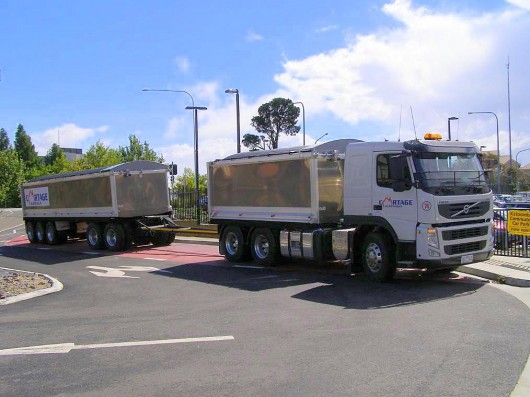 Cartage Australia’s demonstration B-double sand tipper Volvo truck
22 metres long – parked in Katoomba, Blue Mountains.
(Photo by Editor, 20120210, free in public domain, click photo to enlarge) Cartage Australia’s demonstration B-double sand tipper Volvo truck
22 metres long – parked in Katoomba, Blue Mountains.
(Photo by Editor, 20120210, free in public domain, click photo to enlarge)
.
Like most news across the Blue Mountains region concerning issues likely to pose a significant impact upon the community and the environment, one learns about it on the grapevine.
So two weeks ago, I learnt about this Melbourne trucking company planning to introduce 22 metre long B-Double trucks along the Great Western Highway. Such long trucks are currently banned as being too long for this regional highway through the many towns, villages and residential and school zones of the Blue Mountains.
I learn that the trucking company, Cartage Australia, is due to demonstrate one of its B-Doubles to the local community and in the process try to justify why it should be exempt from the current New South Wales Government prohibition. But the announcement is not a general public one, so naturally only a handful of the community turn up to the demonstration, because only a handful of the community were made aware.
.
Why Are Oversized and Overmass Trucks Restricted?
.
Heavy vehicles using the Great Western Highway between Victoria Pass and Lapstone Hill are currently restricted to being no more than 19 metres in length. Such vehicles are deemed to be ‘oversized’ and or ‘overmass’ to mix normally with day-to-day traffic.
According to the RTA’s (recently renamed ‘RMS’)…
“As stated in the General Class 1 Oversize (Load-Carrying Vehicle) Notice 2007 and the General Class 1 Oversize (Special-Purpose Vehicle) Notice 2007, night travel on the Great Western Highway between the Nepean River at Emu Plains and Medlow Bath for vehicles wider than 2.5 metres or longer than 19 metres is only permitted between 1.00am and 5.00am.”
[Source: ‘RTA Operating Conditions Oversize Overmass’ Version 2, 2008, page 23, New South Wales Roads and Traffic Authority, ^http://www.rta.nsw.gov.au/heavyvehicles/downloads/operating_conditions-oversize_overmass.pdf , >Read document (pdf) 720kb]
.
The following justifications identified by the South Australian Director of Road Safety Legislation are just as pertinent to New South Wales:
.
- The need for suitable protection of the State’s road system from structural damage
- The safety and convenience of all road users
- The capability of the vehicle to safely carry the load
- Environmental impacts
- Equitable treatment of all sectors of the industry.
.
[Source: ‘Policy for the Transport of Oversize and Overmass Indivisible Loads and Vehicles, MR 434 06/06, June 2006, South Australian Government, Department for Transport Energy and Infrastructure, ^http://www.transport.sa.gov.au/pdfs/freight/policy_indivisible_vehicles.pdf, Read Document (pdf) 930kb]
.
In New South Wales, rules governing B-Doubles are prescribed under the RTA B-Doubles General_notice_2005 (The Road Transport (General) Act 2005 – General B-Double Notice under Division 4 of Part 2 of the Road Transport (Mass, Loading and Access) Regulation, 2005. >Read Regulation (pdf) (690kb)
.
The Sand Cartage Contract
.
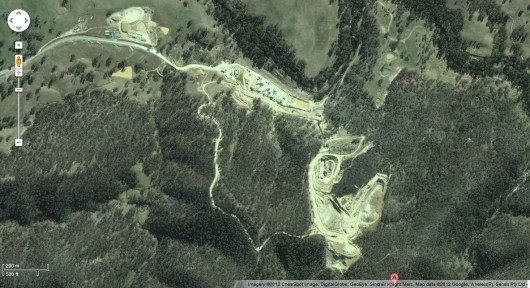 Hy-Tec’s Sand Quarry south of Hartley
(Google Maps)
Hy-Tec’s Sand Quarry south of Hartley
(Google Maps)
.
Melbourne-based construction material trucker, Cartage Australia, is bidding for a sand cartage contract to Hy-Tec to deliver construction sand to the Sydney markets using 22 metre B-double trucks. This will mean many of these long B-double sand trucks dominating the Great Western Highway over the Blue Mountains. The route is to be from Hy-Tec’s sand quarry from Jenolan Caves Rd south of the village of Hartley to Sydney.
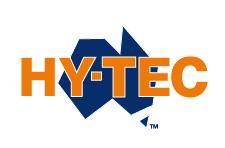
Hy-Tec is a group of companies which are wholly owned by publicly listed Adelaide Brighton Limited, a prominent Australian construction materials and lime producing company with operations throughout Australia. Two major construction projects that Hy-Tec is currently delivering to in Sydney include ‘The Ark’ – a 21 storey commercial high-rise in North Sydney and Presida’s T1 industrial 35,000 cubic metre industrial building complex at the Norwest Business Park in Bella Vista.
Director of Cartage Australia, Wayne Vella, argues that his Volvo fleet of B-doubles are “longer but safer”. Yet according to its website,
“HY-TEC’s focuses on accurate delivery times, taking direct customer enquiries at each concrete plant and quarry, supported by a large fleet of concrete trucks for quick response and best in class on time delivery.”
.
This time-critical delivery focus necessitates that the sand cartage from Hartley to Sydney will be time critical. This means the pressure will be on drivers to meat delivery deadlines and so they be in a hurry and so this poses risks of more trucks and larger heavier trucks speeding along the Great Western Highway, undermining the safety of the road for other road users.
Cartage Australia provides its services 24 hours a day, seven days a week, hauling quarry products around Melbourne – and more recently, throughout Sydney, following the opening of a new facility late last year. This means the sand cartage over the Great Western Highway has potential to be 24 hours a day.
“We opened the Sydney operation so that we can offer the same sort of service to customers there as we provide in Melbourne, and so that we can continue to grow the company. Customers can call the company at any time and we’ll strive to get the job done for them,” says Ray.
Although the Sydney arm of the business has only been fully operational for a few months, Ray is already looking at ways to further grow the business. “Wayne and I want to grow Cartage Australia as much as we can,” says Ray, as he points to further growth planned for 2012.
[Source: ‘Cartage Australia – driven by determination’, Prime Moving Magazine, February 2012, ^http://www.primemovermag.com.au/featured/article/cartage-australia-driven-by-determination]
.
The Big Sell
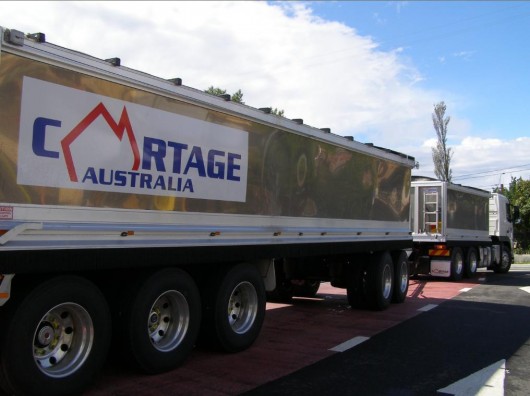
At the outdoors meeting on Friday 10th February 2012 staged by Cartage Australia to a handful of the local community at Katoomba, the demostration truck was all but straight out of the factory. It was bright, shiny, new tyres, flawless and made for selling the company’s point of view. The sell was all about providing Performance Based Standards (PBS) for trucking to get around the 19 metre truck length restriction. That needs to be explained by government.
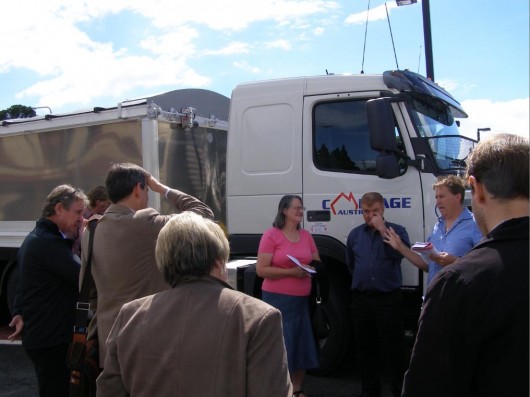 Director Wayne Vella explaining all the positives about his shiny FM480 Volvo Director Wayne Vella explaining all the positives about his shiny FM480 Volvo
.
But when Vella started his long spiel about the truck’s state of the art features and benefits, the focus became all about the magnificence of his showroom truck and not about the community’s concerns about copping more and longer trucks through the Blue Mountains.
Vella argued that it was not a B-double, but look at the photo of it:
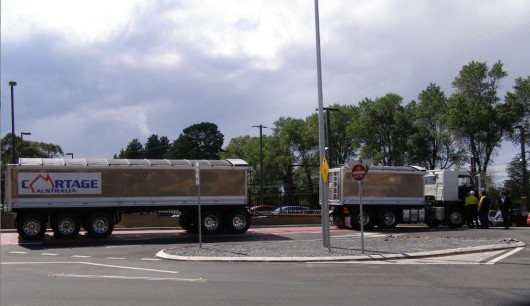 . .
We had to laugh when Vella professed that:
“the exhaust is so clean you could breath it.”
.
“We have applied for a special exemption and this requires us to satisfy all the high performance safety standards in place and also to show the State Government evidence of community support for these trucks. “If we get the nod, we could replace the dog-tipper trucks [used at Hartley Quarry to transport coal to Sydney via the Blue Mountains] with Volvo 500 rigid class trucks within four weeks.”
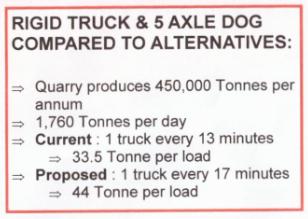 This is Cartage Australia’s current proposal to service the Hartley Quarry
1 truck every 17 minutes This is Cartage Australia’s current proposal to service the Hartley Quarry
1 truck every 17 minutes
.
 This is a Volvo FM480 too and it carts fuel and meets the Euro standards.
A B-double is a B-double. This is a Volvo FM480 too and it carts fuel and meets the Euro standards.
A B-double is a B-double.
.
Here was the politically correct article on the subject published in the local newspaper a few days later. It reads almost as a scripted media release by the trucking company on prime reading page 5.
.
‘Company seeks truck length exemption’
[Source: ‘Company seeks truck length exemption’, by Shane Desiatnik, 20120215, Blue Mountains Gazette, p.5 ^http://www.bluemountainsgazette.com.au/news/local/news/general/company-seeks-truck-length-exemption/2456181.aspx]
.
A Victorian company hopes to gain the support of highway safety lobby groups for a proposal to operate a fleet of “longer but safer” heavy vehicles through the Blue Mountains.
Heavy vehicles using the Great Western Highway between Victoria Pass and Lapstone Hill are currently restricted to being no more than 19 metres in length.
But Cartage Australia has applied to the State Government for a 12-month special exemption to replace its old dog-tipper trucks servicing Hartley Quarry with new 22-metre Volvo trucks.
The company’s director Wayne Vella gave about 15 people a demonstration of the truck’s features at Goldsmith Place in Katoomba on February 10, which include a quiet and energy efficient ‘Euro 5’ standard engine, rollover protection, quiet disc brakes, GPS satellite navigation, 24-hour driver monitoring and larger load capacity.
He said the Volvo trucks set a new benchmark in road safety, did not use noisy compression brakes and three trucks would be able to carry the same load as four dog-tipper trucks, so the number of truck trips per day would decline significantly.
“Yes, the trucks are just under three metres longer than the current limit for the Blue Mountains, but they are not B-double trucks, they only tow one trailer and are only longer to include an extra set of axles to more evenly spread the load,” he said.
“We have applied for a special exemption and this requires us to satisfy all the high performance safety standards in place and also to show the State Government evidence of community support for these trucks.
“We have introduced these trucks in Victoria and we believe if we don’t take this step here you will end up getting older and older trucks on the road that never get replaced.
“If we get the nod, we could replace the dog-tipper trucks [used at Hartley Quarry to transport coal to Sydney via the Blue Mountains] with Volvo 500 rigid class trucks within four weeks.”
Blackheath Highway Action Group chairperson Michael Paag said he would forward information about the proposal at Cartage Australia’s request to members of all highway action groups and other organisations like the Katoomba Chamber of Commerce and Community.
“Members of the general public who are interested in obtaining information or providing feedback about this proposal can contact me,” he said. (Ed. Contact details withheld for privacy).
Mr Vella said he met with Roads and Maritime Services managers in Katoomba also on February 10 to discuss the proposal and notified Member for Blue Mountains Roza Sage in November when the application for the special permit was lodged.’
.
Ed: The message is beware of selective community announcements, as they are selective and not public for reasons to suit the purpose of the protagonist – in this case Cartage Australia’s potentially lucrative contract to truck thousands of tonnes of sand over the Great Western Highway – 1 truck every 17 minutes!
.
NRMA on Truck Safety:
.
Statistics show that road freight continues to grow 1.5 times as fast as the economy, with estimates that freight is expected to double by 2020. The heavy vehicle industry constantly pushes for increases in length and load.
According to the NRMA, it is important for truck drivers to keep a safe following distance. The NRMA believes any changes should be balanced with improved safety and environmental performance. As such NRMA would like to see heavy vehicles equipped with front, side and rear under-run guards (to ensure light vehicles don’t run underneath the heavy vehicle in the event of a crash) and ABS brakes. ABS brakes allow the driver to steer while braking heavily and minimise stopping distances.
NRMA also believes heavy vehicles should be equipped with tamper-proof, on-board monitoring and speed limiting equipment. Electronic on-board monitors can better observe driving hours and driver behaviour.
NRMA also sees a need for increased enforcement of heavy vehicle speed limits. The RTA has introduced its ‘Three Strikes’ scheme, aimed at penalising heavy vehicles which are repeatedly caught exceeding the speed limit (if three strikes are recorded in a three year period the vehicle’s regisitration is suspended). However, they do have to be caught first. A trailer has a different licence plate number to the prime mover which can make it difficult to identify the vehicle when it is photographed from the rear.
NRMA would like to see all heavy vehicle camera enforcement use front and rear detection.
NRMA also supports opportunities to put more freight onto rail where distances are long and freight is suited to rail transport, but it’s naive to think that rail can transport everything.’
.
[Source: ‘Sharing roads with trucks’, by Karen Fittall, ‘Open Road’ members magazine, NRMA, September/October 2005, ^http://www.mynrma.com.au/cps/rde/xchg/mynrma/hs.xsl/heavy_going.htm]
.
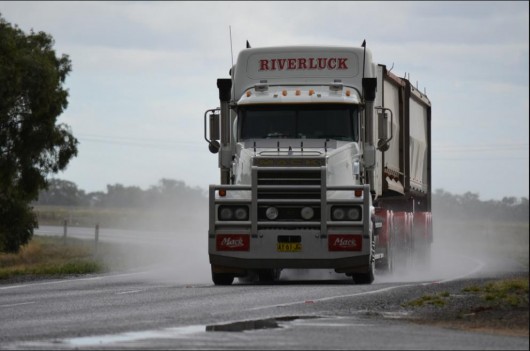 Speeding trucks too dangerous for the Blue Mountains
[Source: ‘Riverluck Mack’ Flickr, ^http://www.flickr.com/photos/quarterdeck/ Speeding trucks too dangerous for the Blue Mountains
[Source: ‘Riverluck Mack’ Flickr, ^http://www.flickr.com/photos/quarterdeck/
.
But the problem is not so much the performance of one trucking company that is aspiring to deliver best practice performance safety, as Cartage Australia is publicly promising.
The problem is the precedent created that permitting one company with 22m long B-doubles will be the thin policy wedge that will allow less conscientious truckers to ply regional roads through residential and school zones. The problem is one of road safety and across the Blue Mountains, road safety especially when it comes to trucks, has a dismal and worsening road toll record. As the Great Westren Highway is transformed into a dedicated high speed trucking expressway, it becomes more dangerous.
Cartage Australia may indeed be offering the safest truck on any Australian road, but who is monitoring and enforcing best practice driver behaviour 24 hours a day? No one!
Road behaviour is simply not monitored and enforced properly by government. As more and bigger trucks speed along our highways, our highways are becoming dangerous life and death environments which is unacceptable.
.
The Habitat Advocate recommends the following standards for the Great Western Highway through the Blue Mountains:
.
- No B-doubles, only semi-trailers, rigid trucks and smaller to be permitted to use the Great Western Highway between Hartley and Penrith. B-doubles to use the Bells Line of Road route.
- NSW Government to suspend all new expressway development, and instead to focus on a Safety First Policy, implementing safety improvements to the current Great Western Highway width between Lawson and Lithgow, noting that the widened sections east of Lawson all but completed or work in progress
- Government and freight industry to mandatorily have feasibility study into rail alternatives for any proposal for increasing road line haul – study to be independent and published online with a month of completion
- Minimum of four speed cameras and four red light cameras installed on the Great Western Highway between Hartley and Nepean River, all hidden and each rotated during the year. This is to be a permanent arrangement.
- Minimum of three speed cameras installed on the Bells Line of Road between Lithgow and Windsor, all hidden and each rotated during the year. This is to be a permanent arrangement.
- Quality controls introduced for heavy vehicle drivers with ongoing spot checks by both Police and RTA (RMS) – including, highway monitoring of driver behaviour – tail gating, exhaust brake usage, speeds, log book compliance, vehicle condition, load safety, mobile phone usage, higher professionalism standards, etc.
- Time-based pay to replace all trip based remuneration of all heavy vehicle drivers across NSW
- Heavy vehicle drivers required to respect and accept variable speed zones across the Great Western Highway, especially through towns and villages and the 40kph zone limits during school morning and afternoon – double demerits for heavy vehicle drivers to reflect the seriousness of heavy vehicles breaching these laws
- A mandatory concrete barrier to be installed on the entire length of the Great Western Highway between Lithgow and Penrith that an withstand collision by heavy vehicles to prevent head-on collisions
- A maximum 75kph speed limit for all heavy vehicles to be imposed on the Great Western Highway between Penrith and Lithgow
- The NSW Government to prepare an economic business case to show the Return on Investment and Pay Back of the Mt Victoria Bypass estimated to cost $1 billion
- Prohibit heavy vehicle parking along the highway in Mount Victoria, particularly in the vicinity of the Caltex Service Station. This to be signposted accordingly, monitored by the RTA (RMS) and fines to apply for transgressions
- RTA (RMS) to construct one fully accredited heavy vehicle rest area at Mount Boyce on both sides of the highway, and a second at Falconbridge on both sides of the highway to fully comply with the standards set by the National Transport Commission’s Heavy Vehicle Driver Fatigue Legislation, which came into effect on 29 September 2008.
.
Postcript:
.
Blue Mountains Gazette 20071001:
Victoria Pass
Monday, 1 October 2007
Posted By Dean Driscoll, Mt Victoria.
‘Another horrific accident going down the hill at Mt Vic on Sunday. The whole zone from just east of the township to the bottom of the mountain is 60km/hour yet a large percentage of drivers going through Mt Vic seem to struggle to brake to that limit. Surely the area must be regarded as a black spot?
With persistant tail-gaters trying to speed their way through as if it was a freeway, it is time the authories give a serious look at how to manage an out of control situation’.
.
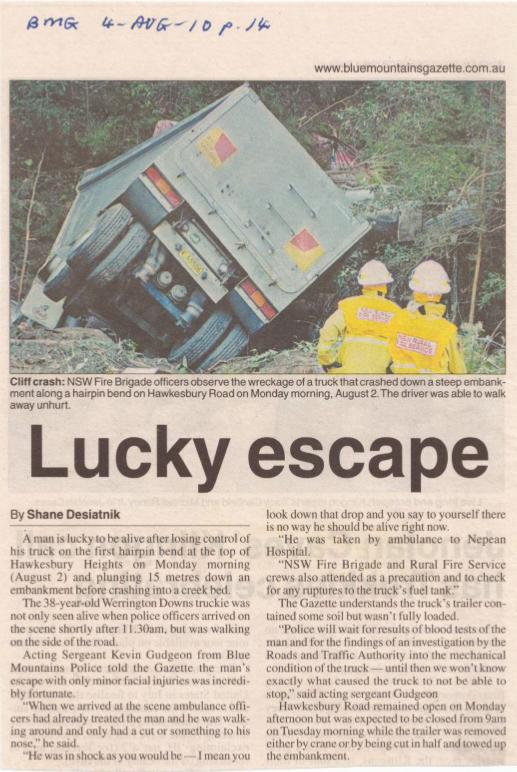
.
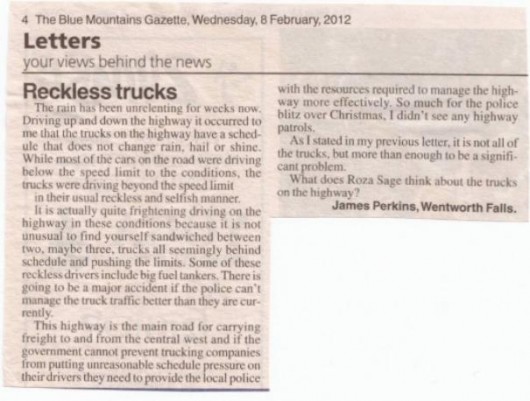 . .
Thursday, February 16th, 2012
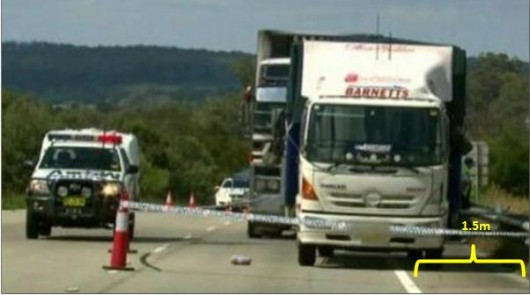 Freeway’s narrow shoulders – obvious death traps Freeway’s narrow shoulders – obvious death traps
Site of another truck killing – this time the Hume Freeway near the Bowral turnoff, New South Wales
.
Another week, another truck “cleaning up people” on trucking expressways. Expressways with more and faster trucks are more dangerous.
.
Not an unusual breakdown:
.
A young woman travelling south in her car along the Hume Freeway suddenly experiences her car overheating on the Southern Highlands section. The woman rightly pulls over into the left service lane (‘freeway shoulder‘) and she rightly calls the NRMA roadside breakdown service for mechanical assistance.
The NRMA rightly attends the breakdown incident and the mechanic arranges for a vehicle tow. The NRMA subcontracts the tow operation out to local Mittagong-based tow truck operator, Highlander Towing. Owner-operator, Geoffrey Clark, rightly attends with his vehicle tray truck and parks in front of the woman’s car in the service lane. At this section of the Hume, the freeway shoulder is substandard in width and so the towing operation protrudes into the outside freeway lane. The breakdown location is later confirmed by attending police that it was situated on a long straight section of the Hume having a good 500 metre visibility to south approaching traffic.
The tow truck had been tipped in readiness to pull the broken down car on to its tray just before the accident. It is believed Mr Clark and the woman were standing on the roadside of their parked vehicles when a southbound truck struck both Geoffrey and the woman at freeway speed. It is about 12:40pm (midday on a clear day). Both Mr Clarke and the still unidentified young woman died at the scene.
Crash investigators were last night trying to work out how the truck failed to see the woman’s maroon-coloured car and Mr Clark’s truck on the side of the road. It is branded a ‘double fatality’. Traffic is stopped causing congestion. Police and paramedics attend, and the scene is assessed for the coroner.
These two people just going about their normal business suddenly and wrongly have become road ‘statistics’. Statistics for the authorities to collate and report.
.
‘Police said the truck literally cleaned up the two people’
~ The Daily Telegraph (Sydney).
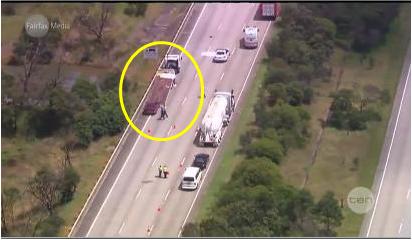
“What chance would anyone have when a truck doing at least 100 kph comes at them?” a police spokesman said.
Yes, roads are dangerous, fast freeways moreso. Cars kill, but trucks kill more easily offering less chance of survival for other road users. When a shoulder on a six laned interstate freeway is designed too narrow to allow safe clearance from high speed traffic, that freeway shoulder is surely a death trap waiting to happen.
Breakdowns beware? If a vehicle breaks down it is involuntary. A driver does not have a choice of continuing on until there is a safe place to pull over, since the vehicle won’t go.
.
The truck killing of two pedestrians is reported to have been horrific. Geoffrey Clark was aged in his 40s and reportedly a father of four. The media have not yet reported the family circumstances of the young woman at the time of publishing today.
 Ave atque vale Geoffrey Clark,
Tow Truck Operator, father-of-four,
and the unidentified standed woman motorist who Geoff dutifully went to assist
(I write that your passings not be in vain) Ave atque vale Geoffrey Clark,
Tow Truck Operator, father-of-four,
and the unidentified standed woman motorist who Geoff dutifully went to assist
(I write that your passings not be in vain)
.
According to media reports, Geoffrey Clark, every time a stranded motorist would call him for help, Geoffrey Clark would drop everything and race to their aid. The tow truck company owner and father-of-four was doing exactly that yesterday when he and a female motorist he was helping were run down and killed instantly.
Mr Clark, who operated Highlander Towing, was attending to a broken down Ford sedan in a lane of the Hume Freeway at Mittagong in New South Wales when he was hit by a truck.
The truck driver, from Barnetts courier company (see previous photo of truck ), was taken to hospital with shock.
Distraught employees and friends last night said Mr Clark was a “one in a million” boss who never said no.
“He’d happily go out to help someone in the middle of the night, that’s Geoff,” one employee said. “He was always ready to help, no matter who they were.”
.
Highlander Towing – customer testimonies
‘Prompt and Friendly Service’
(posted by Mun Lum at Tuesday 26 April 2011)
“Our car broke down in Robertson and the company (NRMA recommended) came out fairly promptly and was very helpful in providing advice on where the car can be towed to and repaired. It was over the Easter long weekend and the workshop was not open so they offered to store it at their place until the workshop opened. Great and friendly service. Thoroughly recommended.”
.
‘Highlander Towing’
(posted by Anonymous User at Thursday 30 April 2009)
“Great blokes, Great Service, Highly Recommended”
.
‘Highlander Towing’
(posted by R Maclean at Sunday 18 February 2007)
“I got stranded at Sutton Forest having hit a wombat and my car had to be towed. The guys at Highlander were great – they arrived quickly, stored the car in their warehouse and found me a motel at 1.30 am (all in a black out in Mittagong). The next day they arranged for the car to be trucked to Sydney and I caught a lift with the car. The two guys I encountered were nice blokes (Ray and John) – as a lone female I was a little anxious about who was going to turn up at midnight. I needn’t have worried – Ray who went out of his way to be helpful. Thanks for the help guys, it is much appreciated.”
.
It was the same fatal stretch of the freeway, which last month claimed the lives of three members of the Logan family in another tragic truck accident.
.
RTA meets budget by skimping on safe freeway shoulders
.
RTA’s Budget Shoulder Contingency
.
The pattern of cost blowouts by the RTA’s Major Infrastructure projects must be legion. Its failure to factor in inclement weather contingency and the poor operational management of subcontractors are typical excuses for its record of material cost overruns. But the RTA has long relied upon an internal engineering contingency that enables it to meet the external budget irrespectively.
It works like this – over the lineal distance of a major freeway upgrade project, every metre of widening costs millions. The multiplier effect of highway/freeway/expressway construction is considerable for every inch that is made wider. Freeway shoulders represent the extremes of that widening.
So over an entire project if the freeway shoulder width is trimmed, total project costs can be reduced substantially. So when vague budget cost estimates show signs of blowing out, such freeway shoulders are the contingency that are trimmed in width and thus cost. And who’s going to notice outside RTA internal design engineering?
Voila! Project on budget and management bonuses paid thank you very much. But tell that to the families of the two innocent people mentioned above who were yesterday using the RTA’s ‘high standard’ interstate six-laned dual carriage Hume Freeway.
.
Narrow freeway shoulders are designed death traps
.
But the narrowing of freeway shoulders may save money but compromises safety. Given that standard truck width is 2.5 metres, all freeway shoulders that are gazetted as designated truck routes for safety reasons need to be designed with at width to safety accommodate a truck of 2.5 metres in width.
The Hume Freeway is one of Australia’s major inter-city highways, running for 880 km between Sydney and Melbourne. It is part of the Auslink National Network and is a vital link for road freight to transport goods to and from the two cities as well as serving Albury-Wodonga and Canberra. At this section through the New Spouth Wales Southern Highlands, the Hume is a six-laned dual carriageway freeway not a highway, which permits a speed limit of 110kpm, it demands a higher standard of safety design. There needs to be an added margin of clearance between a stationary vehicle parked on a freeway shoulder and the traffic including trucks doing 110kph.
Clearly, freeway shoulders on such high speed routes need to have a minimum safety width greater than 2.5 metres.
The RTA (TRMS) is responsible for providing safe freeways to the travelling public and so the RTA the owes all freeway users a general duty of care out of its freeway design including the provision of a safe freeway shoulders. The RTA exercises control over the Hume Freeway, is responsible for its design including adequate freeway shoulders.
In this case of the tragic deaths of the two people on the Hume Freeway yesterday, the RTA has breached that duty of care by providing an unsafe freeway shoulder both from an occupational perspective in the case of the tow truck operator performing a breakdown operation, as well as to freeway users in general. The narrow 1.5 metre freeway shoulder created an obvious and unacceptible danger for any vehicle parked on it that measured over 1.5 metres in width, such as the tow truck (at closer to 2.5 metres in length).
It was the same fatal stretch of the freeway which last month claimed the lives of three members of the Logan family in another tragic truck accident.
 Great Western Expressway
…the Liberal-Labor Government’s Trucking Expressway Vision for the Blue Mountains
(Note the narrow shoulders)
Great Western Expressway
…the Liberal-Labor Government’s Trucking Expressway Vision for the Blue Mountains
(Note the narrow shoulders)
.
The Trucking Expressway Vision – a legacy of Bob Debus MP
.
- Perpetual Four Lanes dividing Blue Mountains communities
- Narrow Shoulder Death Traps
- Unmonitored Continuous 80kph, so nudging 90kph
- Anti-Pedestrian, anti-Schools through towns and villages
- Anti-Wildlife through so-called ‘World Heritage’
- All for bigger, longer, faster trucks and more of them
.
March 2011: Truck hit and run of pedestrian on F3 Freeway
.
A year ago police were called to investigate the discovery of human remains thought to be those of a male on the F3 Freeway near Somersby on the NSW central coast.
On 1st March 2011, human body parts were found strewn across two lanes in what police suspected of a truck hit and run accident. Police were reported searching the area near the Gosford off-ramp north of Sydney, after a motorist reported the gruesome find about 11.45pm near midnight.
.
Revelations: 1990 ‘NSW Heavy Vehicle Crash Study’ by Monash University
.
In 1990, the Australian Federal Office of Road Safety (Canberra) together with the New South Wales Safety Bureau commissioned a study to examine the cause of crashes involving heavy vehicles in New South Wales between 1988-89 and to suggest countermeasures.
In summary, the findings of the study by the Monash University Accident Research Centre in 1990 found that factors that contributed to producing a severe truck crash environment in NSW included undivided highways of poor standard (including narrow shoulders). The study’s recommended counter-measures from the study included road improvements (at blackspots, delineation, road shoulders, culvert protection).
Read ‘NSW Heavy Vehicle Crash Study Final Technical Report‘. (File size: 14MB)
.
NSW Government culpability questions to answer:
.
- What recommendations of the 1990 Monash Report did the RTA implement and where, and not implement and where?
- Why does Australia’s possibly busiest national truck route, the Hume, have substandard freeway shoulder widths to allow for a standard truck, let alone allow for a width of necessary safety margin to separate high speed traffic and breakdown vehicles parked in the shoulder?
- What is the RTA’s standard procedure for addressing vehicle breakdowns on the Hume, notably along the Southern Highlands section of the Hume?
- If standard procedure was followed in this case by both the NRMA and the towing company, how is the NSW RTA (NSW Transport Road and Marine Services) not liable for breaching its public duty of care and contributing to the tragic deaths of these two freeway users going about their ordinary business?
.
Footnote
.
‘Families praise pair killed in highway tragedy’
[Source: ‘Families praise pair killed in highway tragedy’, by Lisa Davies, Sydney Morning Herald, 20120217, p.6.^ http://www.smh.com.au/nsw/families-praise-pair-killed-in-highway-tragedy-20120216-1tbtf.html]
.
‘A tow truck driver and a woman whose car had broken down on the side of the Hume Highway near Mittagong were killed by a passing truck, Wednesday.
Sarah Frazer was finally about to fulfil her dream, which was to study in pursuit of her great passion – photography.
”My car is pretty much all packed up except for my bedlinen and a few loose ends,” the 23-year-old wrote to her aunt on a Facebook page.
But less than 24 hours later, not long after she started out on her ”newest adventure”, she was killed on her way to university in Wagga Wagga. Her faithful car, brimming with her possessions, had failed her when she needed it most, breaking down along the way. Ms Frazer and the man who came to her aid on the Hume Highway were both killed instantly on Wednesday when a truck failed to see them until it was too late. A tow-truck driver and well regarded southern highlands local, Geoff Clark, had rushed to Ms Frazer’s aid when her car broke down on a narrow stretch of the highway, about two kilometres from Mittagong.
Her car could fit only partly in the road’s shoulder, and the two were trying to prepare it for towing. It is believed the truck driver may simply have seen the two vehicles too late.
Ms Frazer, from Springwood in the Blue Mountains and a former student at St Columba’s High School, was described yesterday as ”a truly amazing person”.
”A world traveller, fearless, funny, kind, strong willed, bright and beautiful,” her aunt Kristina wrote on Facebook.
”She was my niece and my friend. I will miss her terribly.”
Another relative described his family’s grief on such a ”very sad day”, saying his ”beautiful, intelligent cousin” had died ”on her way to start a new life” at university.
Police are investigating the crash and the truck driver is assisting with inquiries. The driver was treated for shock at Bowral Hospital.
Mr Clark, a father of four young boys aged 8 to 14, was hailed as a good Samaritan for stopping on the dangerous strip of the highway and volunteering to drive Ms Frazer to Wagga Wagga.
Inspector Mark Wall, from Bowral police, who knew Mr Clark, said he was ”a hard worker and a good bloke”. He had been a truck driver for most of his life before starting his own towing business eight years ago. His widow, Sam, told reporters: ”He was a very caring husband. Thoughtful, just the best really … he did all that he could do to be safe.”
 Sarah Frazer
Ed: Too young. It is not right. Our highways and freeways need to be safer. Sarah Frazer
Ed: Too young. It is not right. Our highways and freeways need to be safer.
.
References
.
[1] ‘ Two killed as truck hits breakdown operation on highway‘, by Alicia Wood, 20120215, ^ http://www.smh.com.au/nsw/two-killed-as-truck-hits-breakdown-operation-on-highway-20120215-1t5lm.html
.
[2] ‘ Two killed in Hume Highway tragedy near Mittagong‘, by Clementine Cuneo, Police Reporter, The Daily Telegraph, 20120215, ^ http://www.dailytelegraph.com.au/news/sydney-nsw/two-killed-in-hume-hwy-smash/story-fnb5f12x-1226271751142
.
[3] ‘ Two killed in crash near Mittagong‘, SkyNews, 20120215, ^ http://www.skynews.com.au/national/article.aspx?id=718772&vId=
.
[4] ‘ Man dies on road as he came to woman’s rescue‘, The Daily Telegraph, 20120216, ^ http://www.news.com.au/national/man-dies-on-road-as-he-came-to-womans-rescue/story-e6frfkvr-1226272184058
.
[5] Highlander Towing Pty Limited, ^ http://www.thesouthernhighlands.com.au/directory/travel/couriers/highlander-towing
.
[6] ‘ Human remains scattered on F3: police suspect hit and run‘, by Stephanie Gardiner, 20110302, ^ http://www.smh.com.au/nsw/human-remains-scattered-on-f3-police-suspect-hit-and-run-20110302-1bdjb.html
.
[7] ‘ Heavy Vehicle Crash Study Final Technical Report‘, Monash, ^ http://www.monash.edu.au/miri/research/reports/atsb092.pdf
.
Thursday, February 2nd, 2012
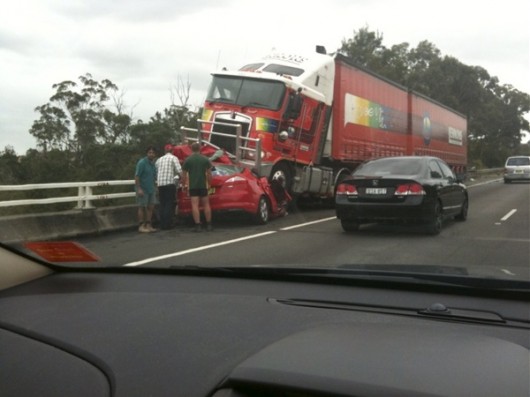 No chance!
A B-Double crosses the wrong side of the Hume Highway
and slams head-on into a car killing all three occupants No chance!
A B-Double crosses the wrong side of the Hume Highway
and slams head-on into a car killing all three occupants
.
Last Friday, a brick-laden truck crossed a grass embankment, crashed through a guard rail and ended up on the opposite side of the Menangle Bridge on the Hume Highway south of Sydney. It slammed head-on into a car killing the three people inside.
[Source: ‘From joy to instant death‘, by Nick Ralston, 20120125, Illawarra Mercury, ^http://www.illawarramercury.com.au/news/local/news/general/from-joy-to-instant-death/2432730.aspx]
.
It is only a matter of time before such a tragedy befalls the Great Western Highway in the Blue Mountains as more and more B-Doubles ply this regional route.
Driving along many highways throughout Australia has become deadly as more and bigger trucks travel faster just a metre away on the other side of a white line or two. Not only are there more semi-trailers, but trucking companies are increasingly putting larger capacity B-double trucks on the road, which can weigh over 70 tonnes.
When 70 tonnes hits you it is an instant wall of death.
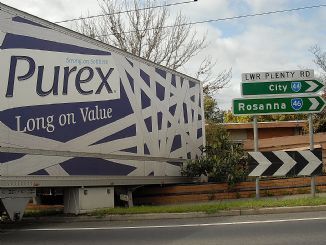 A speeding semi ploughs into the front yard of a home in Rosanna,
in eastern Melbourne on 21st September 2010 A speeding semi ploughs into the front yard of a home in Rosanna,
in eastern Melbourne on 21st September 2010
.
Yet both Liberal and Labor governments at both national and state level are pouring billions of taxpayer dollars to facilitate more road freight on Australian highways, while ignoring the comparative line haul efficiencies and inherent safety of rail freight.
In 1998, the New South Wales Labor Government announced a 12-year $360 million ‘upgrade’ of the Great Western and Mitchell Highways between Penrith (outer Sydney) and Orange in the central west of NSW. In addition, the Federal Liberal-National Coalition Government committed an extra $100 million as part of its Auslink National Network.
The ‘upgrade’ meant transforming the two lane regional highway over the Blue Mountains into a four lane 80kph expressway to facilitate greater and faster trucking – a ‘trucking expressway‘. The then promoted features of this new trucking expressway were to be:
- Widening of the highway to a four lane, divided road between Penrith and Katoomba
- Widening the highway to mostly three lanes between Katoomba and Mount Victoria (including Blackheath)
- Providing additional overtaking lanes along stretches of the highway
- Improving pedestrian and traffic facilities at intersections crossing the highway in townships
- providing bicycle facilities along the highway
- Extensive landscaping and urban design initiatives within Blue Mountains towns and villages.’
.
[Source: NSW Roads and Traffic Authority Great Western Highway Upgrade’ brochure, January 2002]
.
Well, the widening is certainly carving through Blue Mountains communities and bushland. Pedestrian walkways and crossings are few and far between and the few cycle lanes are within a metre of B-doubles hurtling along at 80kph – those that stick to the speed limit. Who’d be a cyclist on the Great Western Highway now unless one had a death wish?
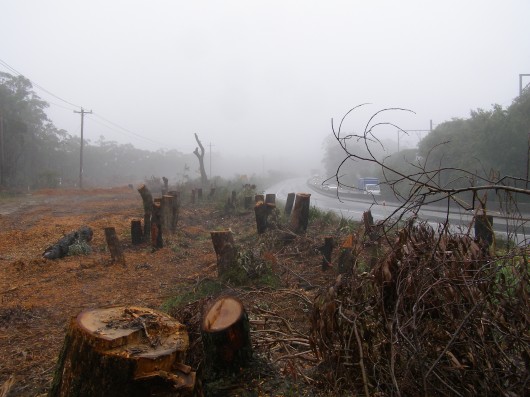 Destruction in progress yesterday at Boddington Hill, east of Wentworth Falls
Great Western Highway Blue Mountains
(Photo by Editor 20120201, free in public domain, click photo to enlarge) Destruction in progress yesterday at Boddington Hill, east of Wentworth Falls
Great Western Highway Blue Mountains
(Photo by Editor 20120201, free in public domain, click photo to enlarge)
.
In September 2008, the then Federal Labor MP Bob Debus for the Macquarie electorate (covering the Blue Mountains region) committed another $450 million on the Great Western Highway to bypass the village of Mount Victoria and River Lett Hill near Lithgow.
Debus revealed the purpose of the widening on his website:
.
“The bypass will halve times between Mt Victoria and Lithgow, reduce accidents by two-thirds, and improve freight transport from the Central West .
The bypass will provide a route on the western escarpment more suited to the operation of heavy vehicles than the current Victoria Pass…”
.
[Source: ‘Bob Debus for Macquarie E-news #2‘, Bob Debus MP website, ^http://www.bobdebus.com/newsletter2.html (page since defunct since Debus has resigned from Federal Parliament]
.
The joint Labor-Liberal policy focus on developing road freight and ignoring rail freight is short-sighted 20th Century truck thinking. But it is also meaning our regional highways are morphing into bigger and faster freight routes – trucking expressways. Local communities are having to share regional roads with huge trucks.
The trucking industry has allowed itself to become largely contract based where drivers instead of being paid for their time driving are paid on a trip rate. This means that the more trips a driver makes and the faster the delivery times, the more money the drivers earn. This work arrangement only encourages truck drivers to drive faster, often too fast, with disastrous consequences.
.
‘It is a statistic that will alarm police and governments dealing with a string of fatal road accidents: almost two thirds of long haul truck drivers interviewed for a national study say their employers pressure them into using unsafe work practices.’
[Source: ‘Truckies pushed into danger zone’, by Andrew West, Sydney Morning Herald, 20100109, p.2]
.
Recent fatalities on NSW roads , including the death of an 11-year-old boy, have sparked a renewed call for action on trucks in the Mountains.
Deputy Mayor Mark Greenhill moved a matter of urgency at Blue Mountains City Council (BMCC) meeting 31st January 2012, calling on state and federal government representatives to meet with BMCC to discuss “means and methods by which large trucks can be limited or controlled in terms of behaviour on the Great Western Highway over the Blue Mountains” following several shocking incidents in other areas of the state.
Clr Greenhill: “While the courts have not yet had a chance to determine guilt or otherwise, and I don’t seek to either, recent accidents on NSW roads stand testimony to the awesome power of these trucks,” he said. “In the Campbelltown area a large truck went over the top of a car and killed three people. They had no chance. In coastal NSW a boy was killed while sleeping in his house when a large truck ploughed through it.”
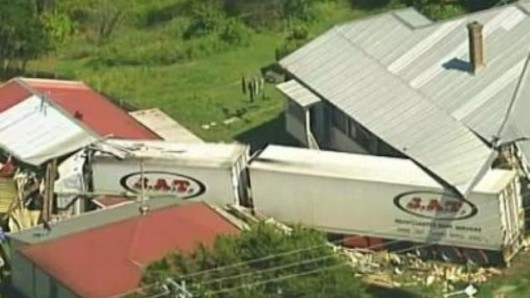 Eleven-year-old boy killed when a B-double crashes through his bedroom
Anyone living within 100 metres of a highway has got cause for concern Eleven-year-old boy killed when a B-double crashes through his bedroom
Anyone living within 100 metres of a highway has got cause for concern
.
Penrith residents are mourning the death of Max MacGregor, the 11-year-old killed when a truck loaded with bananas crashed through his bedroom on the state’s mid-north coast. Max was asleep in the holiday home his family were renting in Urunga when, at 5am on Sunday, a B-double semi collided head-on with a ute before swerving into the holiday home (100 metres from the highway).
[Source: ‘B-double fatality on mid-north coast brings Penrith family’s holiday to tragic end’, by Emma Schiller, 20120110, Penrith Press, ^http://penrith-press.whereilive.com.au/news/story/penrith-familys-holiday-tragedy/]
.
Clr Greenhill: “When things go wrong and [trucks] are out of control, they are an uncompromising and deadly weapon. “In that context, people have been killed in significant numbers in the Blue Mountains. It is a scandal to me that governments are not doing more to control tucks on the highway across the Mountains. “This should especially be the case while the highway works are under way.”
Clr Greenhill released BMCC figures in September last year that showed trucks were over-represented in local crash statistics and motorists were three times more likely to die in a collision with one. The statistics showed that from 2005 to 2009, trucks represented nearly a third of all vehicles involving deaths despite being less than a third of vehicles on local roads. Three per cent of all truck crashes were fatal, compared to one per cent of crashes by all other vehicles, the figures showed.
Clr Greenhill said he had reports from local residents about large trucks “even braving the Old Bathurst Road bends”, and said he would like to see vehicles such as B-doubles off local roads for the time being.’
[Source: ‘Tragedies spark call for action on trucks’, by Krystyna Pollard, 20120201, Blue Mountains Gazette, ^http://www.bluemountainsgazette.com.au/news/local/news/general/tragedies-spark-call-for-action-on-trucks/2440033.aspx]
.
‘Give Rail a Go’
[Source: Letter to the Editor, Blue Mountains Gazette, 20120201, p4]
.
The tragic accident involving a 25/26m B-double truck at Menangle last week reaffirms the fact that the Great Western Highway, even after the upgrade to Katoomba is completed, will never be suitable for these massive trucks.
Yet the federal government is funding stage one of a multi-billion dollar highway bypass between Mt Victoria and Lithgow, the main purpose being to allow 25/26/30m B-double trucks carrying up to 77 tonnes to use the highway through the Blue Mountains. Despite overwhelming community disapproval the federal government is pushing ahead with stage one, a purpose built 25/26/30m B-double bypass at River Lett Hill.
The Blackheath Highway Action Group along with many other Blue Mountains Groups successfully lobbied for an independent review to be conducted on the proposed Mount Victoria to Lithgow highway bypass and the future of the highway west of Katoomba. In July 2011 the NSW government appointed Evans and Peck, a firm with local knowledge to conduct this review. the review was completed in November so why is the federal government stalling on its public release?
The federal government refuses to fund a $5 million rail study, a key recommendation of the Central West Transport Needs Study. Rail deserves the same funding, tax incentives and regulatory framework as is currently given to support long haul trucking.
For the sake of safety, local amenity and the long term sustainability it’s time to give rail a fair go and permanently abandon plans to spend billions to turn our highway inot a 25/26/30m B-double freight corridor.’
~ Michael Paag, Chairman, Blackheath Highway Action Group, Blue Mountains
.
‘Head-on crash: driver dies as truck explodes’
[Source: ‘Head-on crash: driver dies as truck explodes’, by Glenda Kwek, 20120124, Sydney Morning Herald, ^http://www.smh.com.au/nsw/headon-crash-driver-dies-as-truck-explodes-20120124-1qehm.html]
‘A driver has died after a truck caught fire and exploded following a head-on collision between the tabletop truck and B-double took place about 24 kilometres south of Dubbo at Mountain Creek Road about 4am, emergency services said. The Newell Highway in Dubbo is closed in both directions between Mitchell Highway and Tomingley Road. The tabletop truck was carrying food and plastic food containers, and the B-double was carrying fertiliser, Ms O’Connor said.’
.
‘Orange truck rollover’
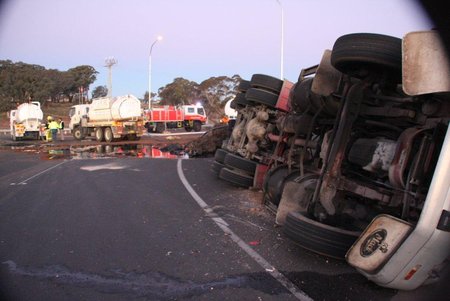 Truck Roll Over at the intersection of Burrendong Way & The Northern Distributor
Orange, Central NSW, 20100629
[Source: ‘Orange truck rollover’ by Steve Smith, Rural Fire Service, Canobolas, ^http://www.canobolas.rfs.nsw.gov.au/dsp_content.cfm?cat_id=131107] Truck Roll Over at the intersection of Burrendong Way & The Northern Distributor
Orange, Central NSW, 20100629
[Source: ‘Orange truck rollover’ by Steve Smith, Rural Fire Service, Canobolas, ^http://www.canobolas.rfs.nsw.gov.au/dsp_content.cfm?cat_id=131107]
.
‘Teenage driver killed in truck collision’
[Source: ‘Teenage driver killed in truck collision’ by Ellen Lutton, 20111218, Brisbane Times with AAP, ^ http://www.brisbanetimes.com.au/queensland/teenage-driver-killed-in-truck-collision-20111217-1p0ax.html]
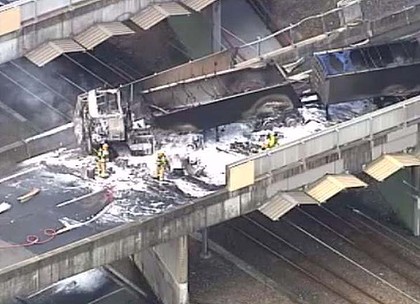
‘One woman was killed and five people were injured in two accidents involving B-double trucks. Engineers were called to the scene of a dramatic accident on the Gateway Motorway at Boondall in Brisbane about midday yesterday, when a B-double truck exploded after it and a car collided. The intensity of the explosion and subsequent fire was so severe that parts of the truck fused together, raising concerns about damage to the road and overpass bridge underneath, a police spokeswoman said.
(Meanwhile) on the Bruce Highway near Rockhampton, a 19-year-old woman died and four people were injured when a car and a B-double truck collided. Police said the station wagon tried to turn into the southbound lanes of the Bruce Highway at Marmor just before 8pm on Friday when the car and truck, which was travelling in the northbound lane, collided.
The 19-year-old driver was killed, while her three female passengers, two aged 19 and one aged 18, were taken to Rockhampton hospital. The three are in a stable condition.The 65-year-old driver of the B-double was taken to hospital for precautionary treatment and has been released.
.
‘Three trucks involved in two separate highway collisions’
[Source: ‘Three trucks involved in two separate highway collisions’, by Wendy Marshall and Kate Moody, 20100408, Daily Liberal, ^http://www.dailyliberal.com.au/news/local/news/general/three-trucks-involved-in-two-separate-highway-collisions/1797078.aspx]
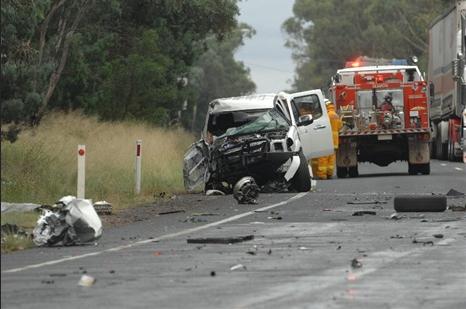
A 50-year old man was taken to Dubbo Base Hospital with serious injuries after a collision between a B-double truck and a utility vehicle, occurred about 1.15pm on the Newell Highway just south of Gilgandra.
Earlier in the day, in a separate accident, two trucks collided 25 km outside of Dubbo on the Golden Highway. A UD truck crashed into the back of a Mitsubishi Canter turning right at the Barbigal Road turn off to Wongarbon about 11.40am yesterday.
At the scene, Ballimore RFS deputy captain Col Buckler said the Golden Highway was not currently built for trucks and “most definitively” needed upgrading.
“This is the official B-double road to Newcastle (and) the roads need to be built to carry trucks,” Mr Buckler said. “It’s time they spent money to make it safer because of the amount of trucks that use it.”
.
‘Fatal crash between car and truck causes explosion, closes Pacific Highway’
[Source: ‘Fatal crash between car and truck causes explosion, closes Pacific Highway’, by Nathan Klein, The Daily Telegraph, 20110405, ^http://www.news.com.au/fatal-crash-between-car-and-truck-closes-pacific-highway/story-e6freuy9-1226033739809?from=public_rss]
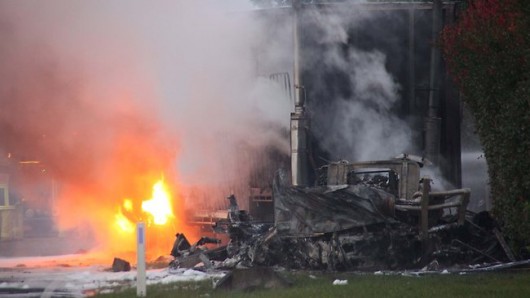 Flames … scenes from a fatal crash between a B double truck and a car on the Pacific Highway south of Macksville.
(Photo by Frank Redward) Flames … scenes from a fatal crash between a B double truck and a car on the Pacific Highway south of Macksville.
(Photo by Frank Redward)
.
AT least one person has been killed in the fiery collision between a car and a B-double truck at Warrell Creek, about 10km south of Macksville, just before 4am today.
“The B-doubles can’t pass using the diversion as the rail overpass is not suitable for their weight,” a spokesman for the Roads and Traffic Authority told AAP.
The truck involved in the crash was carrying chemicals and exploded in flames on impact, but Fire and Rescue NSW extinguished the blaze. One person from the car has been confirmed dead, but police say it’s not clear how many people were in the car when it crashed.
.
‘Driver’s lucky escape’
[Source: ‘Driver’s lucky escape’, 20100730, Cowra Guardian, ^http://www.canobolas.rfs.nsw.gov.au/dsp_content.cfm?cat_id=131113]
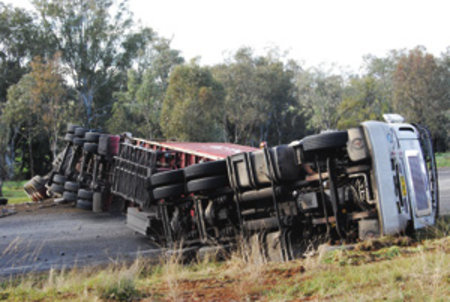 The overturned B-Double truck 2km south on the Boorowa Road The overturned B-Double truck 2km south on the Boorowa Road
.
‘A Canberra man was lucky to escape without serious injury after the B-Double truck he was driving along the Boorowa Rd overturned at 6.15am on Wednesday morning. The 42 year old man lost control of the vehicle 2km south out of town and ran off the road, before the entire truck overturned and spilled out over both lanes of the road.
The overturned truck was carrying furniture and concrete slabs and left more than a dozen slabs scattered over the road. Local resident Russell Denning said he heard a ‘monstrous bang’ when the truck crashed on the road near his home.
Senior Constable John Newton said a lack of attention from the driver appears to be the cause of the accident but police are still investigating.
“At this stage it appears the driver was distracted but there are still final enquiries to be completed,” he said. “My understanding is the driver will receive an infringement for negligent driving.”
.
Tags: B-double crashes, b-doubles, Blackheath Highway Action Group, Blue Mountains, Great Western Highway, head-on, Menangle Bridge, Mt Victoria bypass, RTA, truck collision, trucking expressway, Urunga, walls of death
Posted in Blue Mountains (AU), Threats from Road Making | 5 Comments »
Add this post to Del.icio.us - Digg
Tuesday, January 17th, 2012
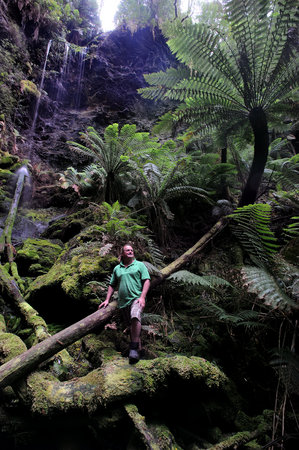
Tarkine National Coalition (TNC) has questioned the motives behind the watering down of the EPBC assessment approach to the Tarkine Road proposal in Tasmania.
The Federal Environment Minister Tony Burke has opted for the less stringent Public Environment Report approach despite the original Tarkine Road proposal being subject to an Environmental Impact Statement approach prior to it’s withdrawal. This comes on top of the Minister’s refusal to National Heritage List the area despite the former proposal triggering a Emergency National Heritage Listing in 2009 by former minister Peter Garrett (lapsed by Minister Burke in 2010).
“There are some questions here that the Minister must answer. Clearly the revise Tarkine Road proposal is not being subjected to the same scrutiny as the original proposal, at a time when the risks to the area are even better understood than in 2009,” said Tarkine National Coalition spokesperson Scott Jordan.
The resubmitting of the Tarkine Road proposal by the Tasmanian Government called into play a promise made by Minister Burke in December 2010 that if the Tarkine Road was resubmitted, that he would immediately re-list the Tarkine. The Minister failed to deliver on that promise.
TNC has maintained conditional support for the revised project, subject to the altered route, staging of the project sections and there being demonstrable evidence that proposed mitigation measures address the expected increase in roadkill of Tasmanian devil and Spotted tailed quoll normally seen with road sealing. So far no mitigation trials have been conducted and that evidence does not exist.
“The lowering of the bar doesn’t make sense given that the state government is increasing it’s efforts to reduce the impact of the road. I suspect pressure is coming from other sources”.
“In my estimation, the lowering of the assessment approach has less to do with the alterations to the route, but the fact that a mining company now needs this route for transporting product to ports”.
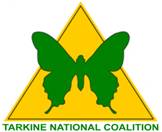 . .
‘Few understand how much transport influences land use patterns. Transport leads land use. Once an expressway or railway is built, it is easy to change the zoning and development laws to increase the population along the corridor.’
[Source: Then New South Wales Minister for Planning, Frank Sartor, Sydney Morning Herald, 20080929, p11]
.
‘A road desecrates wilderness
and enslaves wildness’
~ Editor
.
.
Tuesday, January 3rd, 2012
[The following article was initially published as a letter in the local Blue Mountains Gazette (BMG) newspaper on page 4 by this Editor 20081008 under the title ‘RTA Juggernaut‘. It was sparked by reading two separate letters in the paper from Bullaburra residents angry with the RTA and the highway widening process. Copies of those letters are at the end of this article – one by long time Bullaburra resident Viki Wright Rivett; the other by lifetime Bullaburra resident and local historian Una King.]
.
Note: RTA = New South Wales Roads and Traffic Authority; GWH = Great Western Highway
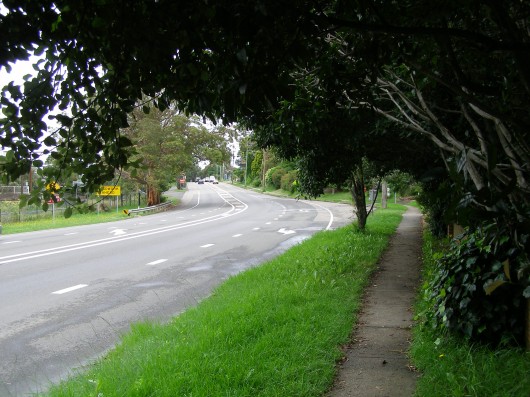 Bullaburra’s rural amenity
Looking east along Great Western Highway towards Railway Station (left)
(Photo by Editor 20110115, free in public domain, click photo to enlarge) Bullaburra’s rural amenity
Looking east along Great Western Highway towards Railway Station (left)
(Photo by Editor 20110115, free in public domain, click photo to enlarge)
.
Decades of complacency and naivety, or do residents of bucolic Bullaburra simply deserve rights to quiet enjoyment and their buena vista? The RTA highway juggernaut is at the door. It won’t just ‘bisect’ the community [‘Anger at RTA‘ BMG 1-10-08]; it will permanently segregate it, raze its rural amenity and degrade it into a noisy truck side stop. Bullaburra is set to receive the same utility vision imposed on Blaxland and so many other Mountains communities.
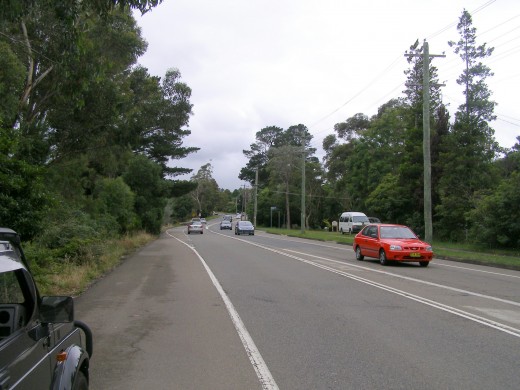 Bullaburra looking east along Great Western Highway towards Noble Street (far centre)
(Photo by Editor 20110115, free in public domain, click photo to enlarge) Bullaburra looking east along Great Western Highway towards Noble Street (far centre)
(Photo by Editor 20110115, free in public domain, click photo to enlarge)
.
I too attended the August township meeting at Bullaburra’s Progress Association hall, not as a Bullaburra resident, nonetheless as a Mountains resident. At the packed meeting, Bullaburrans unanimously endorsed an alternative plan asking the RTA to accommodate local linkages across what will become another four-lane barrier dividing a local community. Personal experience in dealing with the RTA at Leura, Medlow Bath and Katoomba affirms it doesn’t listen or care. It has just plundered the rare 1820s convict road at Leura, hardly pausing its schedule.
 Bullaburra: “Blue Skies” Village – reads the sign (Aboriginal translation)
Western approach to Bullaburra along the Great Western Highway
(Photo by Editor 20110115, free in public domain, click photo to enlarge)
Bullaburra: “Blue Skies” Village – reads the sign (Aboriginal translation)
Western approach to Bullaburra along the Great Western Highway
(Photo by Editor 20110115, free in public domain, click photo to enlarge)
.
The RTA’s massive budget is only limited by political will. It stands to be key recipient of the new Building Australia Fund of $22,000,000,000 then claims it can’t afford community bridges. Be clear, the RTA’s mandate for ‘progress’ is to build more expressways. Driven by road lobbyists, the RTA is extending greater Sydney’s swelling suburbia like Roman legions extended empire.
‘Few understand how much transport influences land use patterns. Transport leads land use. Once an expressway or railway is built, it is easy to change the zoning and development laws to increase the population along the corridor.’ [Then NSW Minister for Planning, Frank Sartor, SMH 29-9-08, p11].
RTA performance is measured by it maximising road ‘ride quality’ and minimising ‘travel times.’ The RTA juggernaut will remain unstoppable so long as local townships rely upon single-handed last ditch battles. Our freshly elected Mountains councillors should stand up for the people of Bullaburra.
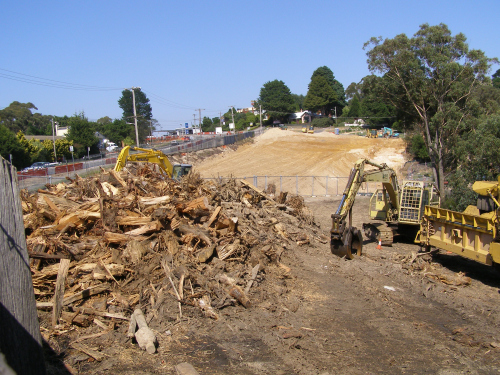 This is what awaits Bullaburra – destruction of rural amenity This is what awaits Bullaburra – destruction of rural amenity
Clearfelled mature native trees at Katoomba to make way for a wider faster trucking expressway
Same project, different section.
(Photo by Editor 20090501, free in public domain)
.
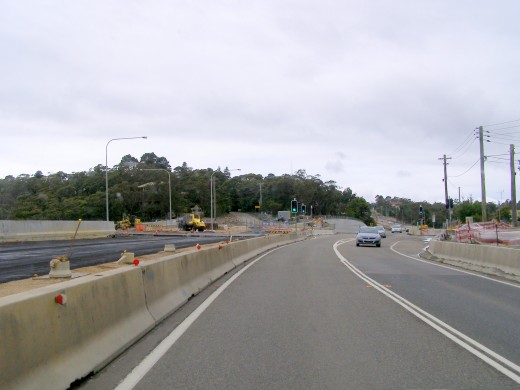 More of what awaits Bullaburra – a trucking expressway amenity! More of what awaits Bullaburra – a trucking expressway amenity!
Eastern approach to Wentworth Falls near Rest Easy Motel (off photo to right).
(Photo by Editor 20110115, free in public domain, click photo to enlarge).
.
.
Following this letter in the weekly local paper, the next week (20081015) the Chairman of the Bullaburra Township Committee, Mr Will Silk, responded as follows:
.
‘Missed Target’
letter by Will Silk in BMG 20081015
.
‘I really don’t know where the author (BMG 08.Oct.2008) is coming from, but he seems to have parachuted into a campaign in the dark and has missed the landing zone.
Steven, a word, to you and other latecomers who are just now arriving from above to hitch themselves to the Bullaburra bandwagon – take the time to find out more about us partisans and the grounds on which we have to work.
At the recent Bullaburra Town Meeting, if you weren’t so blinkered by your condescending stereotyping of a “bucolic Bullaburra”, with its residents slumbering in selfish “complacency and naivety”, you might have seen, heard and, possibly, learned some things of interest to residents’ right activists, environmentalists and radical democrats.
You correctly observed a packed meeting of Bullaburra residents as they unanimously (re-)endorsed the Bullaburra Township Committee’s (BTC) plan to manage the way in which the GWH goes through Bullaburra, and condemned the RTA’s plan.
But, hey, Steven! Where did the BTC Plan come from? It came from 18 years’ proactive work by Bullaburra residents and their organisations. We saw the RTA “juggernaut” coming a long time ago, and instead of just whingeing, we developed our own plan before the RTA did, and we united behind it!
You failed to see that at the meeting, the BTC Plan (with its three integral foundations of pedestrian trian bridge), service road and North-South Bullaburra road-rail bridge) has the unanimous support of all the community organisations in Bullaburra. You also failed to hear all of the now elected ward councillors give our plan their support. And moreover, you didn’t see the now mayor, Adam Searle, and from the Liberal side, Chris van der Kley both, literally “stand up”, together and not for the first time, to show their support.
Far from being naive and complacent, Bullaburra, and the BTC have already put in the hard yards of “politically correct” struggle; delegations, submissions, lobbying. What you failed to see at the meeting was a community gearing up, giving its representatives a very clear mandate, for the next stage in its struggle for a renewed, people and environmentally-friendly village.
We are not “at a last ditch”. But we are about to go to the barricades. We encourage you and all Blue Mountaineers who care about creating such townships to join us if you wish. But leave the mocking paternalism behind. Seeing the RTA as an “instoppable Juggernaut” is defeatist. It is a sort of jaded fatalism that is itself an impotent form of complacency.’
~ Will Silk, President of the Bullaburra Township Committee.
.
.
Harsh defensive words from Mr Silk.
I chose not to reply to Will Silk’s above letter in the local paper, because to have done so would have only detracted Bullaburra residents from their united focus behind Will Silk to deal with the RTA. The aim of my letter had merely been to awaken fence sitting residents to the realisation of the force and power they were dealing with at the RTA. I had witnessed similar David v Goliath community campaigns along the highway, most notably at adjacent Lawson, each village/town community singularly convinced that their case was special and naively campaigning in isolation against the legal might and finances of the RTA.
So I was happy to withdraw my involvement at the time to avoid potential conflict, yet my protest campaign in the local paper broadly against the Trucking Expressway continued through into 2010.
What Mr Silk didn’t realise was that I had been actively involved in previous community campaigns concerning the RTA highway widening stretching back to 2001 when I first arrived in the Blue Mountains. Previous highway campaigns have included Shell Corner (2001-02), Soldiers Pinch (2001-02), Lawson (2003-09), Leura section 1 (2004-05), Medlow Bath (2005 ), Leura section 2 (2006-08), Katoomba (2006-09), Mount Victoria bypass (2006-08) and Bells Line of Road (2005-07).
What Mr Silk also didn’t realise was that at the time I was contracting as a management accountant with the RTA, with some insight into the mechanisations, agendas and management culture of this very much political organisation. What Mr Silk also didn’t realise was that I had researched the history of Bullburra and learnt about the RTA plans for the highway widening through the town.
The RTA plans are set to divide Bullaburra by a faster four-laned expressway, greatly restricting local access and offering very few design concessions to local residents.
.
.
I didn’t have to wait long for the optimistic Bullaburra community sentiments to sour about the likely success of the BTC’s alternative highway design.
The above letter in the local paper by Mr Silk a Chairman of the Bullaburra Township Committee, saw the following week a media release by the Bullaburra Township Committee, headed up with a photo including Will Silk.
.
‘Bullaburra joins highway battle‘
by Michael Cleggett (journalist), BMG 20081022, p3.
.

‘The RTA’s highway-widening roadshow continues to attract jeers wherever it arrives, and this time it’s Bullaburra residents voicing anger at plans for their stretch of tarmac.
Members of the Bullaburra Township Committee (BTC) are furious their own designs for the upgrade have seemingly been ignored.
BTC president Will Silk is concerned the RTA has not fully accounted for the effect of any works on the village and its people.
After years of campaigning to different levels of government and departments, residents were dismayed by the RTA proposal when it was made public earlier this year.
“We went in to see them in the first week of June this year and not to our surprise, but to our disgust, we found that they didn’t even know about our plan, they hadn’t taken it into consideration,” Mr Silk said.
In anticipation of the highway upgrade the community has been looking into the issue for more than 20 years. The three pillars of the BTC designs are a road bridge connecting north and south Bullaburra, a comprehensive service road on the southern side running parallel to the highway and a pedestrian bridge. None of these form part of the RTA’s proposal.
Mr Silk said the BTC’s vision presents a much better opportunity to create “a modern 21st century village with the unavoidable highway through the middle of it”.
The service road is intended to allow residents to traverse the town without having to make a difficult turn onto the highway while the bridges would avoid permanently dividing the town as well as providing easier emergency vehicle access. This stage of work will expand the highway to two lanes in each direction from Noble Street to 600 metres west of Genevieve Road.
Outside of the widening, the main features of the RTA plans involve relocating the commuter car park to the southern side of the highway, moving the pedestrian crossing lights, an access road for some properties between Genevieve Road and Noble Street and a number of other changes to street access and bus stops.
Member for Blue Mountains Phil Koperberg has expressed a willingness to further examine the issue.
“(The BTC) proposal for a link bridge between north and south of the Great Western Highway obviously has merit,” he said. “However, whether or not it is practical, feasible or constructable I’ll take advice from the RTA.”
An RTA pamphlet delivered to residents suggests that advice will be bad news. It describes a comprehensive access road and a pedestrian overbridge as unfeasible.
A spokesperson for the RTA said an information session earlier this month was well attended with “some worthwhile suggestions . . . put forward, which will be investigated”.
A second information session will be held by the RTA from 10am-1pm at Lawson Bowling Club this Saturday, October 25.’
.
.
This article by the Bullaburra Township Committee was then followed up by Bullaburra resident Patrick Tatam, who clearly had a stronger interpretation of how discussions between locals and the Roads and Traffic Association were proceeding.
.
‘RTA Bullaburra fiasco’
by Patrick Tatam, Bullaburra (letter in BMG 20081029, p4)
.
‘Regarding the obstructionist, bullying attitude of the RTA towards the Bullaburra Township Committee (BTC), attacking the BTC’s proposed alternativeplan for the GWH rod widening through Bullaburra, here’s my take on what locals are saying:
- The major political parties are basically inept, unable to listen to constituents and consumed with retaining/grasping power
- Phil Koperberg (then local Labor MP) has no effectively influential power, says anything to avoid an issue, is “a bit of a show pony”, and has furthered his career utilising the ‘who you know, not what you know’ approach
- The RTA is seen as a mob of bureaucratic bullies, are even more incompetent than their political masters (the Hazelbrook railway bridge fiasco is common knowledge), and are responsible/answerable solely to the faceless bosses located deeply within the termite mound of RTA headquarters.
- RTA representatives at community meetings are aggressive, non-consultative, driven only by their own preferred agendas, ill-prepared, and are the antithesis of ‘public servants’
- Exiting either Boronia or Genevieve Road is currently dangerous, and will become definitely more so with the planned RTA ‘seagull’ intersection, increased speed restrictions (from 70kph to 80kph) and higher traffic volumes (particularly those larger faster trucks).
- The BTC’s plan is a far better solution for the Bullaburra area than the ‘crash through or crash anyway’ RTA proposal; it’s a plan that addresses the needs of the people who live here, not the needs of a termite from a city office, and incorporates beneficial infrastructurec, not just ‘bloody minded’ bitumen.
.
Elected government members, and RTA personnel, should realise that they are our representatives, and that locals are becoming more politically astute, voting more for independents, if only to make our representatives more representative. Those bullies that remain, hiding behind the skirts of party machinery, should recall the destiny of the dinosaur. Or just move to the last bastions of ‘Bullyville’: Zimbabwe, Myanmar, etc.
~Patrick Tatam, Bullaburra.
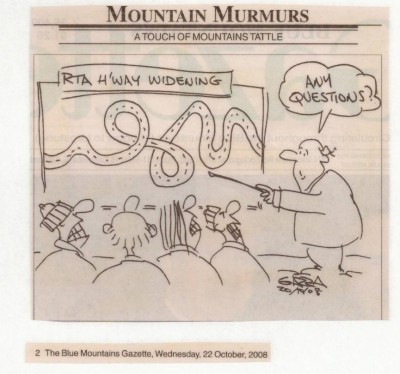
.
.
Editor’s Campaign to Save Bullaburra’s 300+ year old Angophora tree from the RTA
.
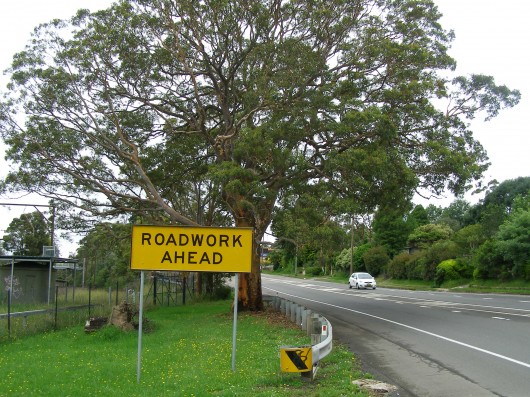 Bullaburra’s Angophora – on RTA’s death row Bullaburra’s Angophora – on RTA’s death row
.
Listed on Blue Mountains Council’s Significant Tree Register
Registered Significant Tree #: 29
Botanical Name: Angophora costata
Common Name: Smooth Barked Apple, Red Gum
Date Registered: 17th July 1985, adopted 21st June 1988
Location: Great Western Highway, Bullaburra, Opp. Lot 173, DP13407.
[Read Significant Tree Register]
.
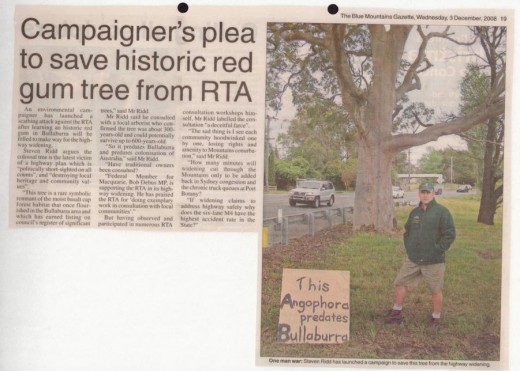 Campaign article in Blue Mountains Gazette 20081203, p19.
.
This followed a quarter page campaign article published in this newpaper on 20081105 costing this Editor $460.
(Click image to enlarge) Campaign article in Blue Mountains Gazette 20081203, p19.
.
This followed a quarter page campaign article published in this newpaper on 20081105 costing this Editor $460.
(Click image to enlarge)
.
.
Letters by Bullaburra residents 20081001
.
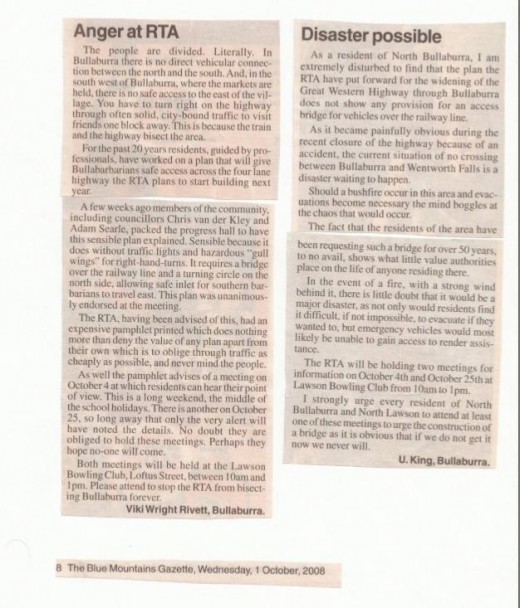 (Click image to enlarge) (Click image to enlarge)
.
|
|
 Six Foot Track being bulldozed into a two-laned RFS Fire Trail
(Photo by Daniel Kelton, 20120802)
Six Foot Track being bulldozed into a two-laned RFS Fire Trail
(Photo by Daniel Kelton, 20120802)
 [Source: ^http://www.adventure.com.au/SixFootTrack.asp]
[Source: ^http://www.adventure.com.au/SixFootTrack.asp]
 The 19th Century Heritage of the Six Foot Track
(An old photo at the information shelter at the start of The Track)
The 19th Century Heritage of the Six Foot Track
(An old photo at the information shelter at the start of The Track)
 Six Foot Track bulldozed beyond recognition
(Photo by Daniel Kelton, 20120802)
Six Foot Track bulldozed beyond recognition
(Photo by Daniel Kelton, 20120802)
 NPWS Oberon Area Manager, Kim De Govrik, in mock bandage leading a protest rally last June
NPWS Oberon Area Manager, Kim De Govrik, in mock bandage leading a protest rally last June Oberon Man?
Oberon Man?
 In the past two weeks, many of the so called ‘improvement areas’ have subsequently
returned to their original boggy state even after little to no rain.
This begs the question: Why the works where carried out in the first place?
In the past two weeks, many of the so called ‘improvement areas’ have subsequently
returned to their original boggy state even after little to no rain.
This begs the question: Why the works where carried out in the first place?
 You reckon?
You reckon?
 Aboriginal rock implements found along the bulldozed section of the Six Foot Track
Aboriginal cultural sites have been reportedly destroyed
at Mini Mini Saddle, Kyangatha Station and Alum Creek.
.
Aboriginal rock implements found along the bulldozed section of the Six Foot Track
Aboriginal cultural sites have been reportedly destroyed
at Mini Mini Saddle, Kyangatha Station and Alum Creek.
.
 Oberon Man’s Day Off?
Oberon Man’s Day Off?
 In August 2005, recent bulldozing of the Six Foot Track was inspected
by local Indigenous people and members of the Blue Mountains Conservation Society
In August 2005, recent bulldozing of the Six Foot Track was inspected
by local Indigenous people and members of the Blue Mountains Conservation Society Oberon Man after a big night out?
Oberon Man after a big night out?
 .
.




















































































